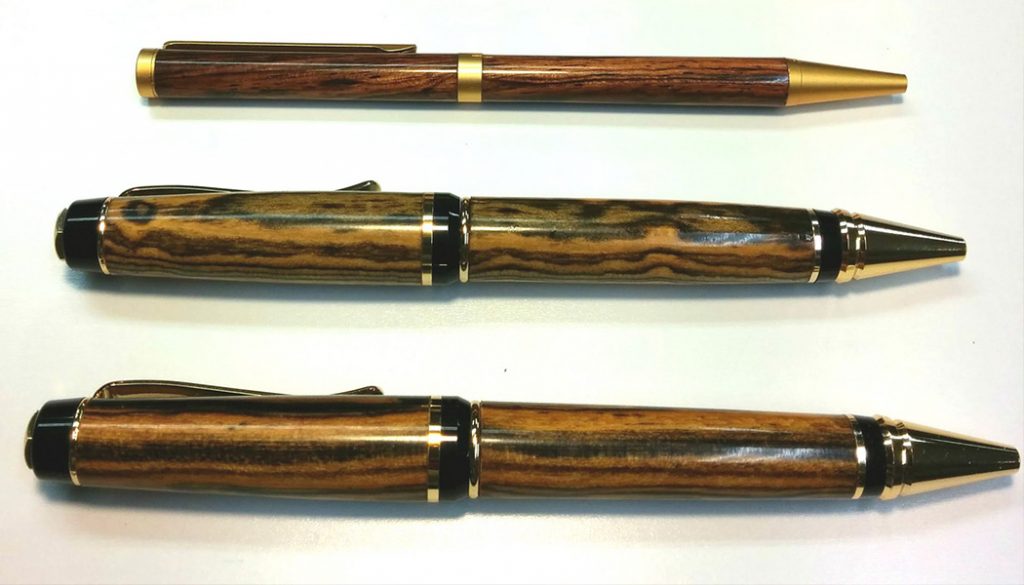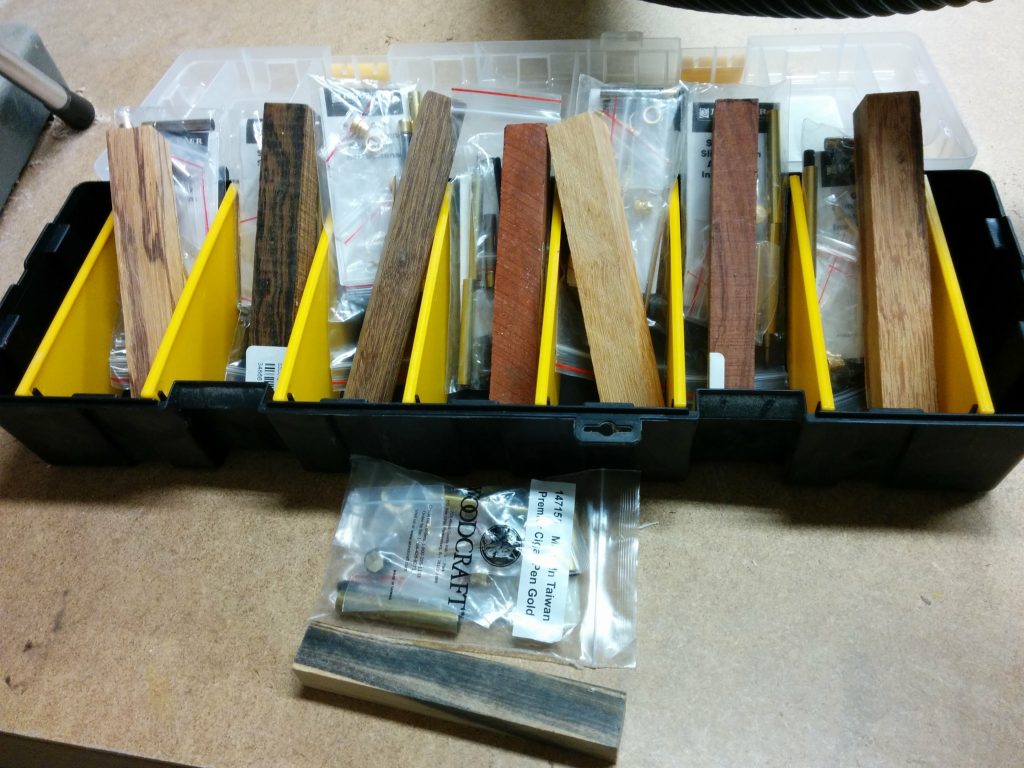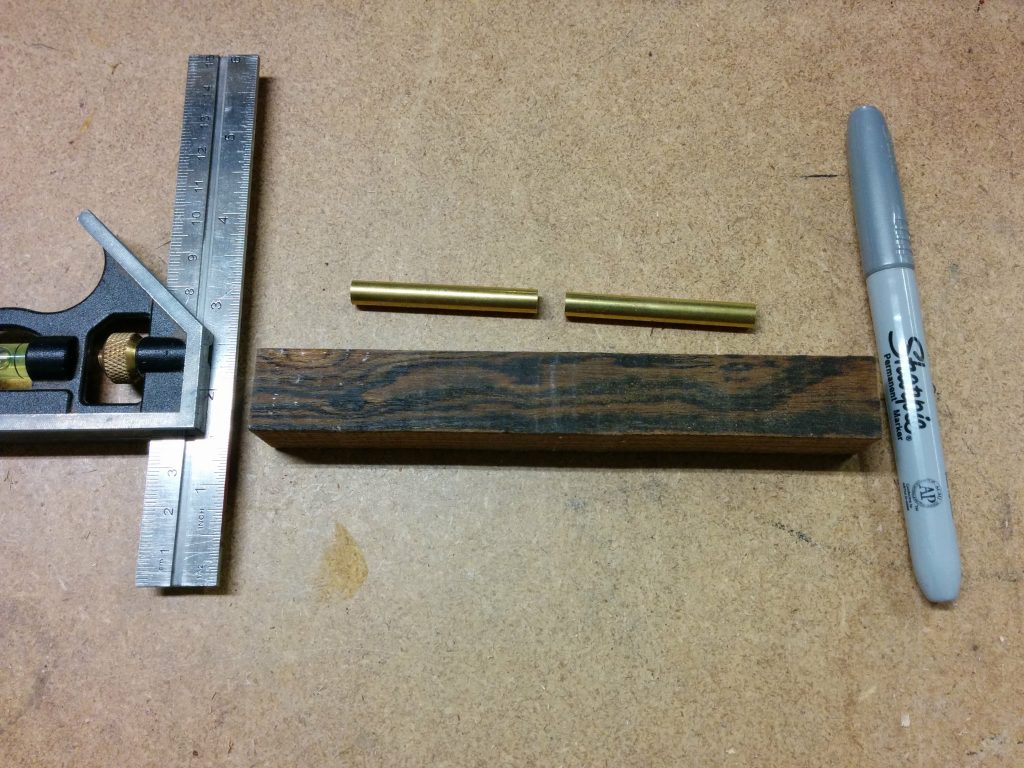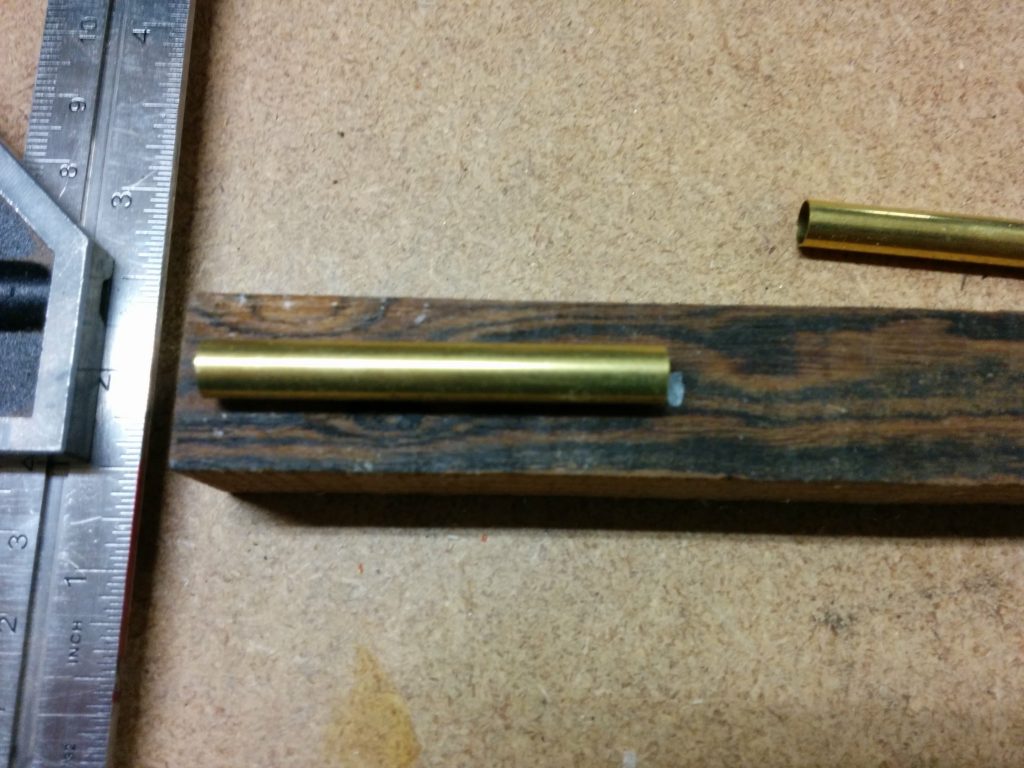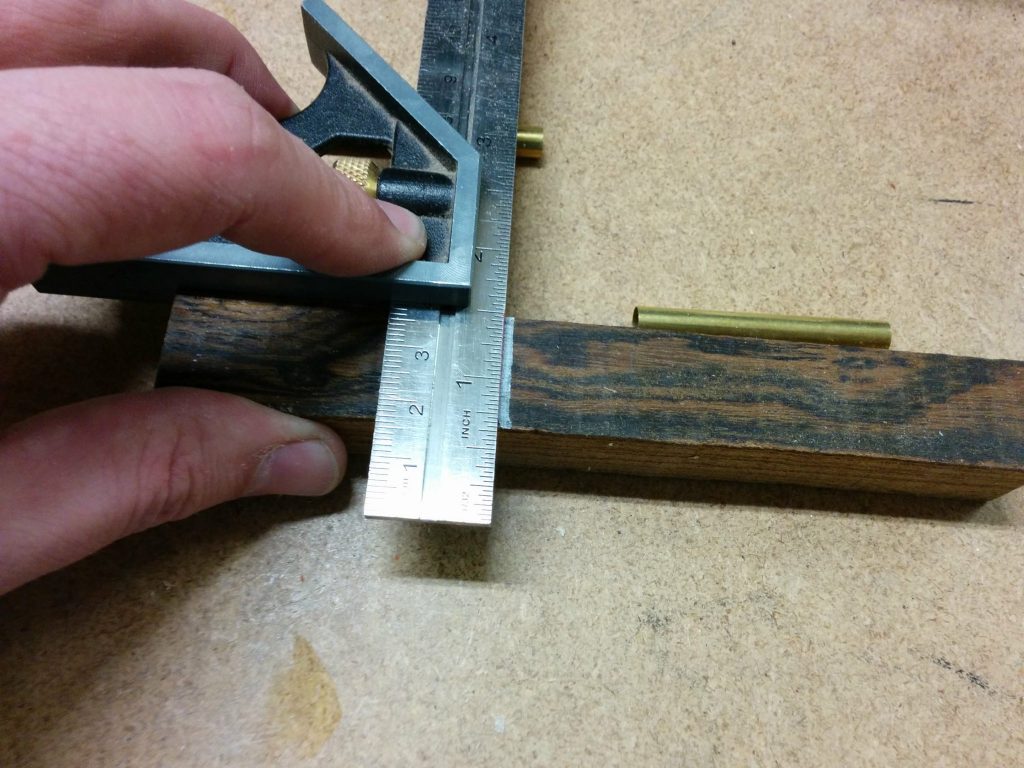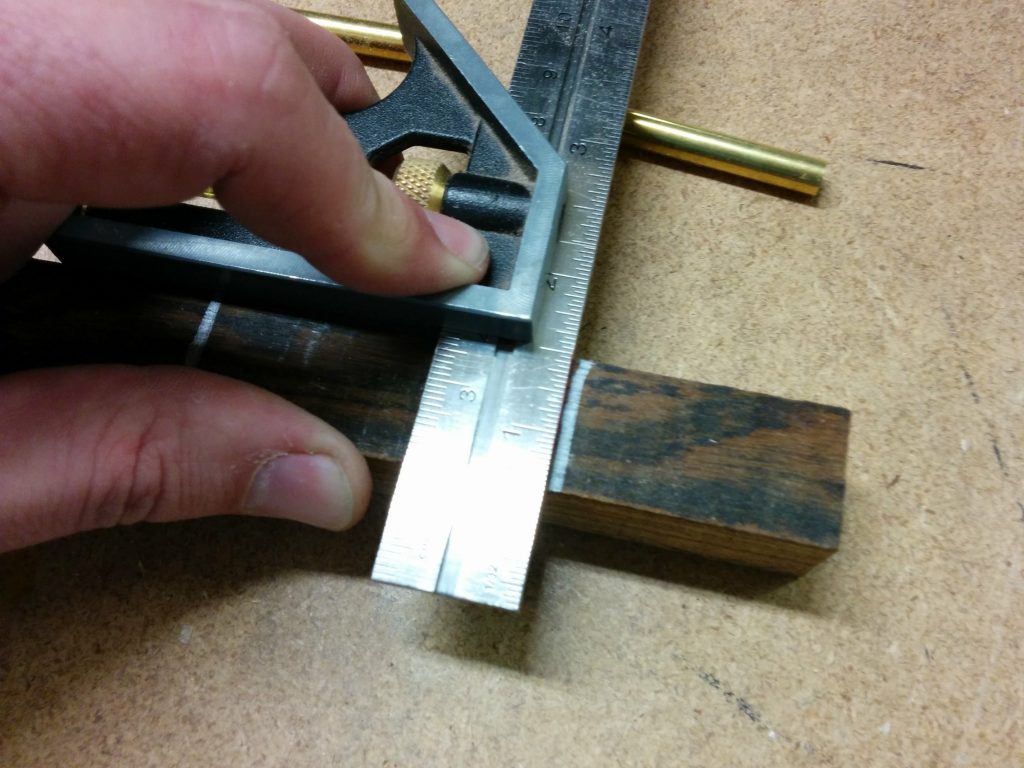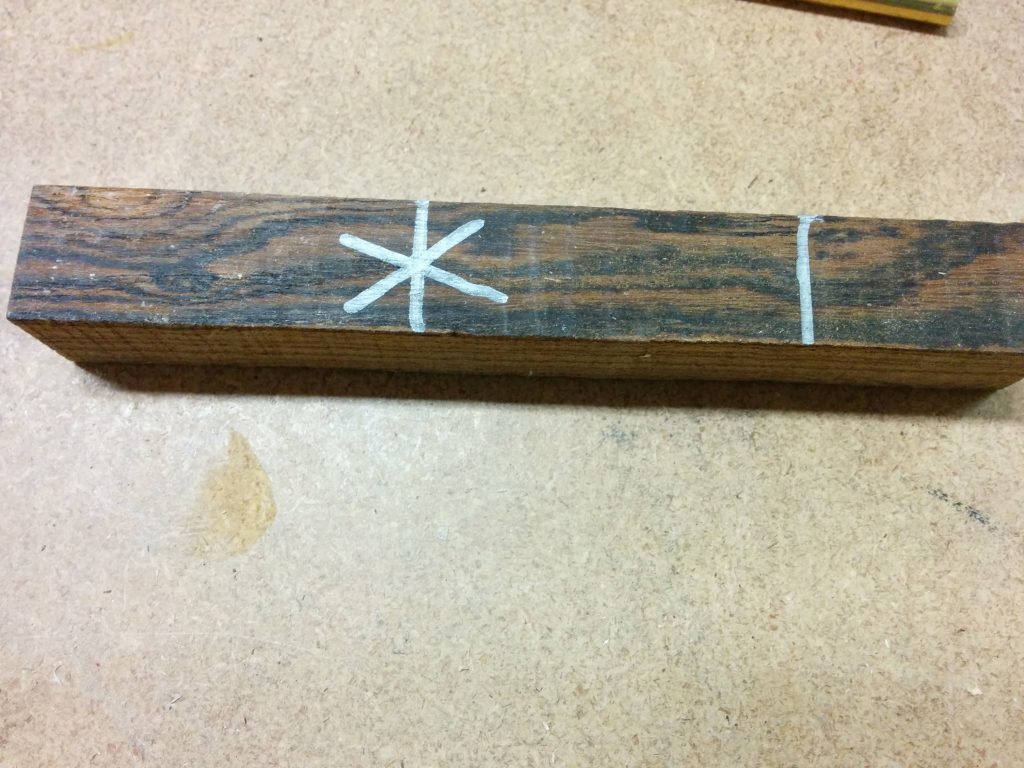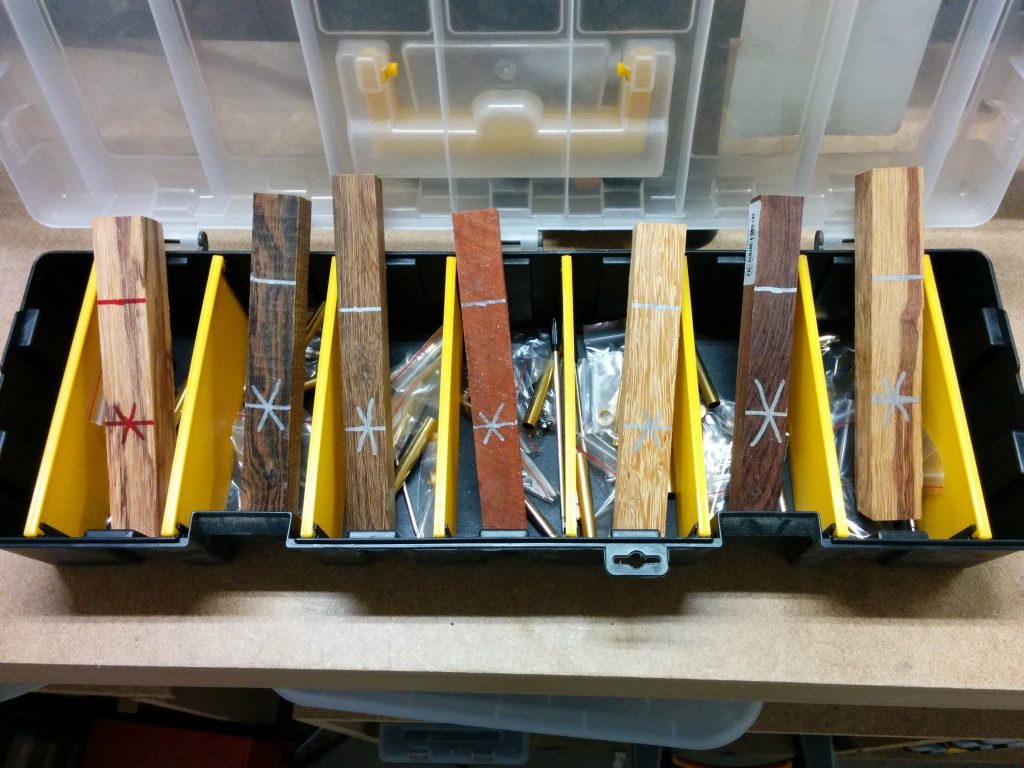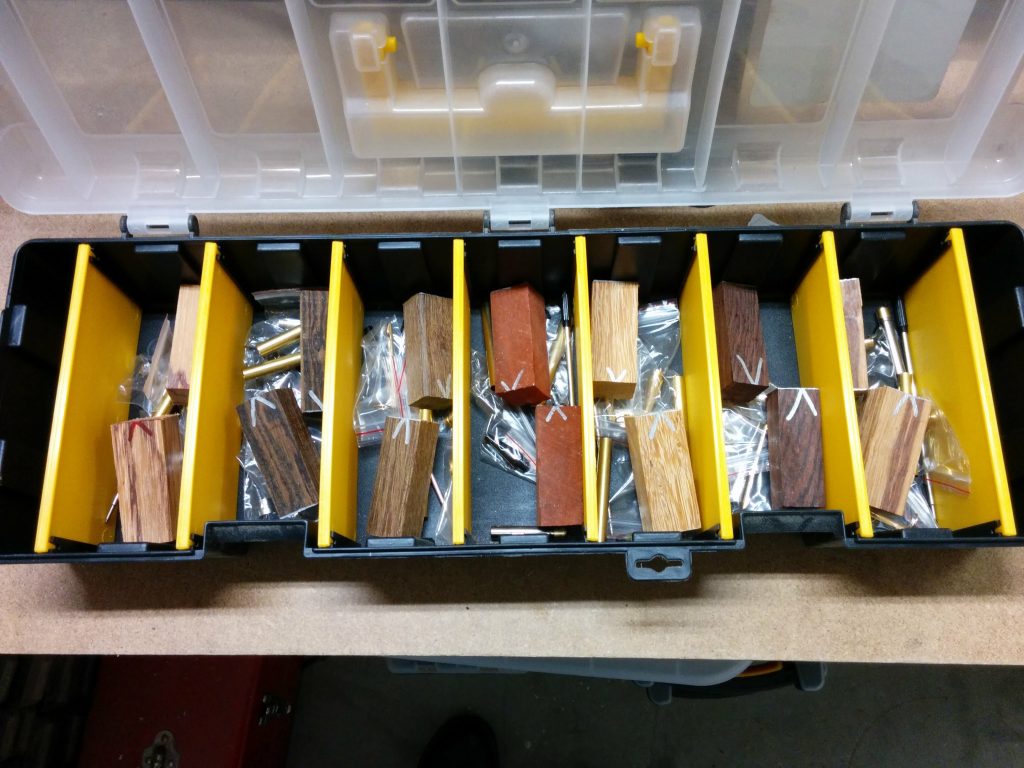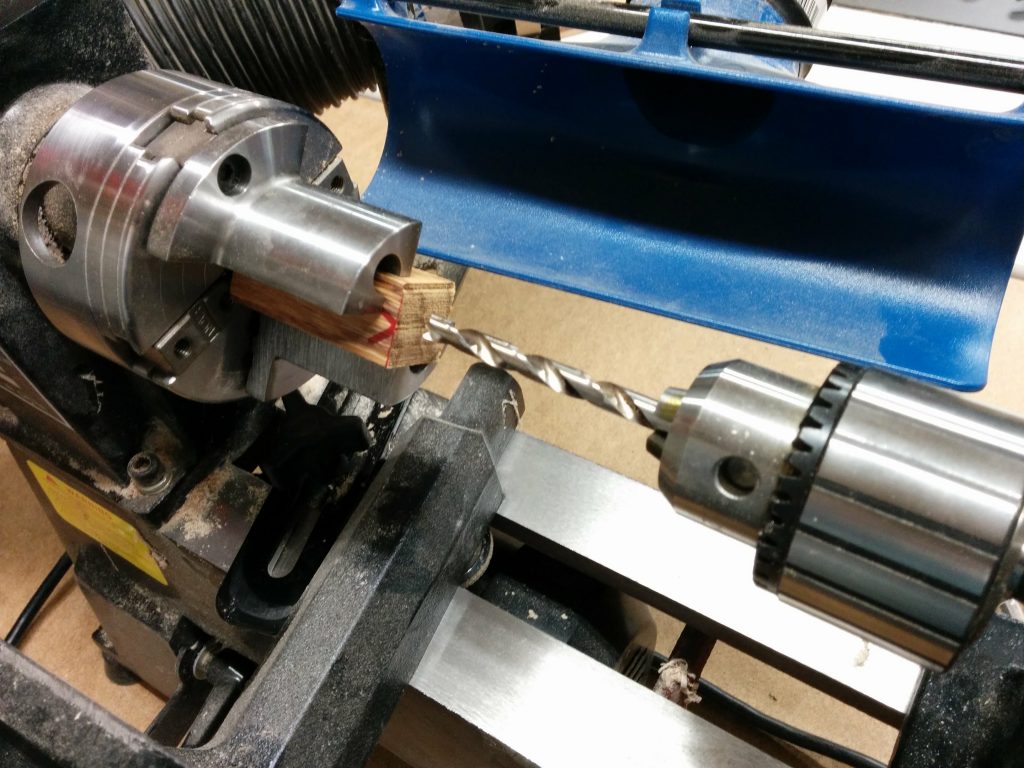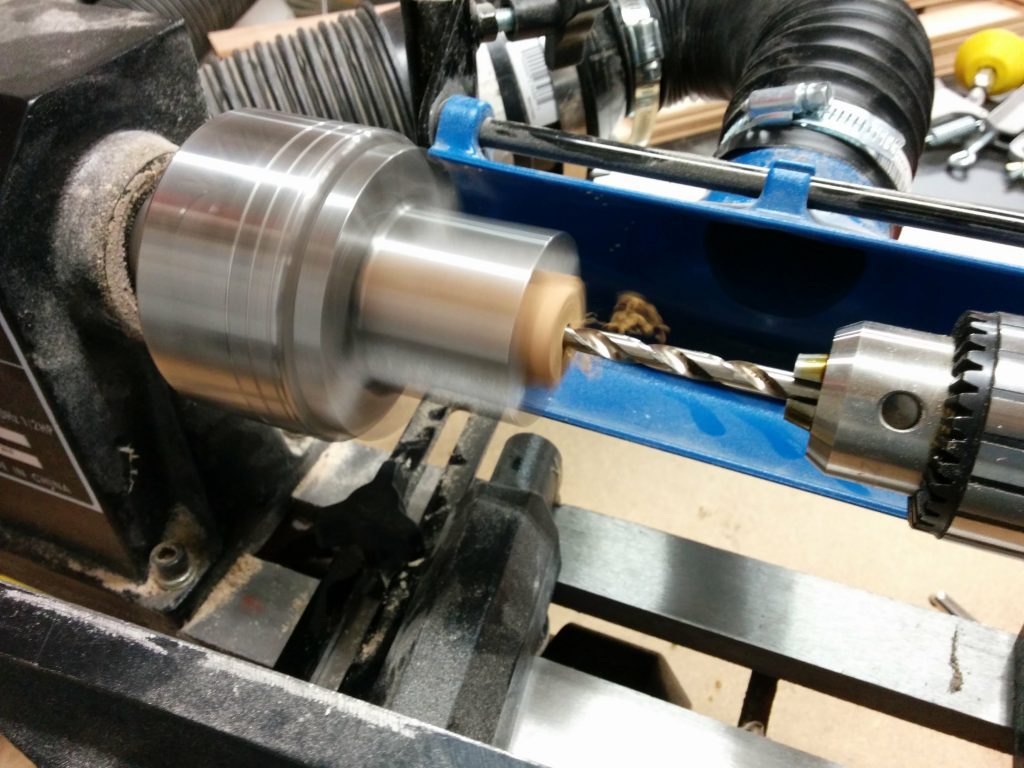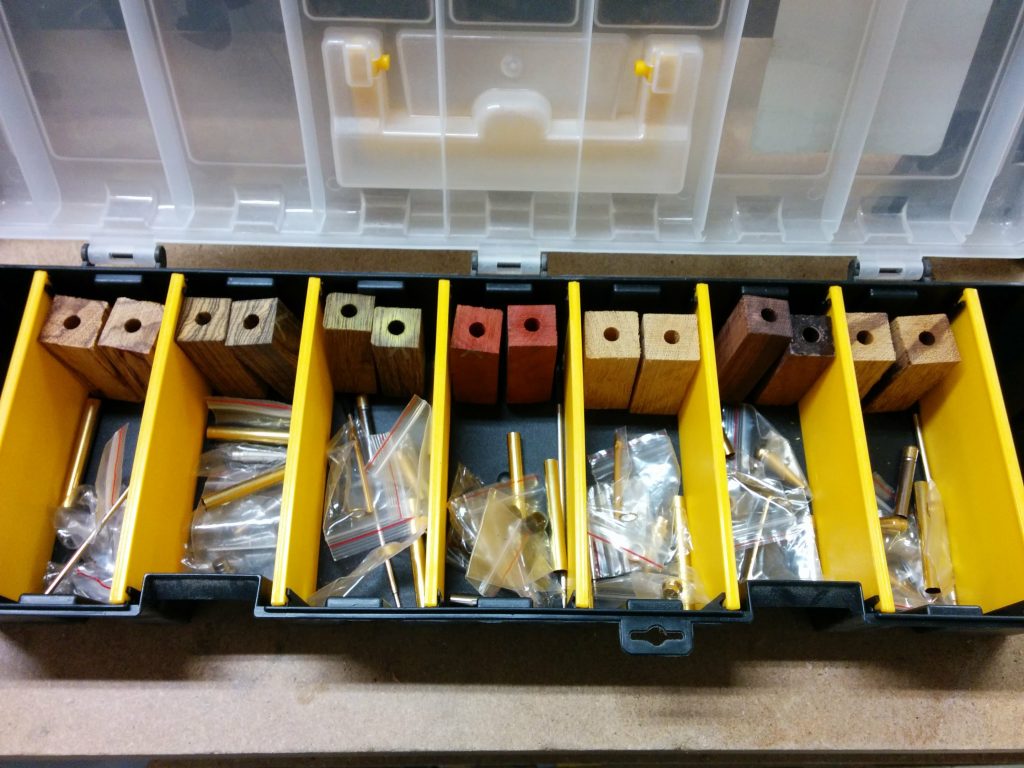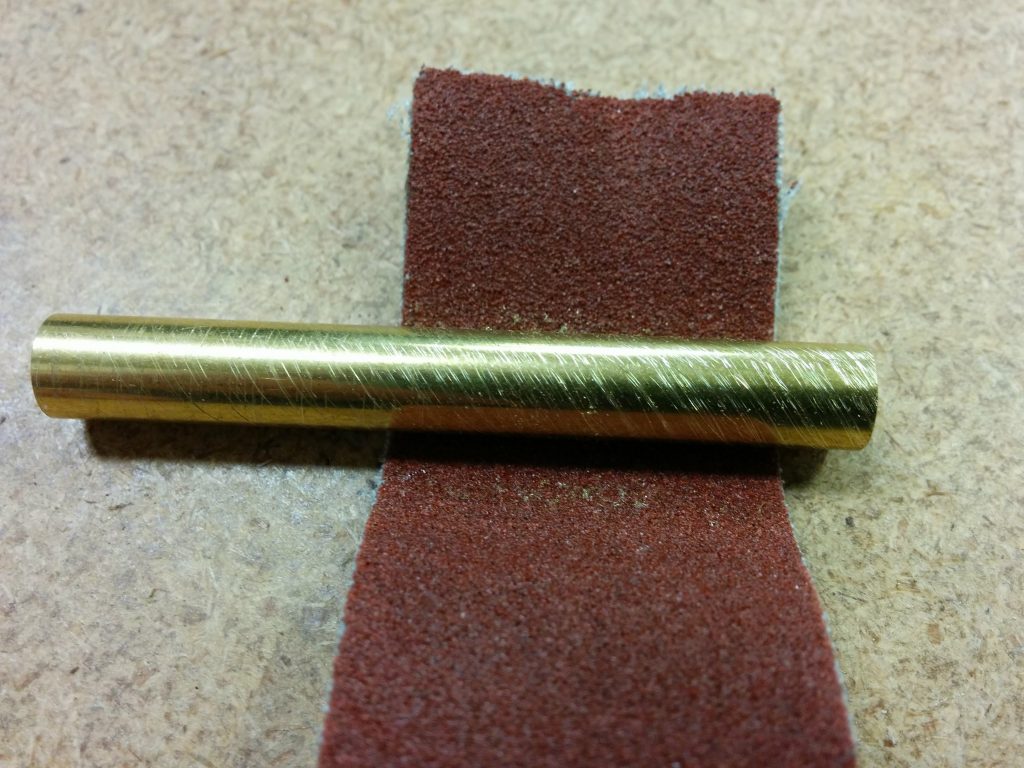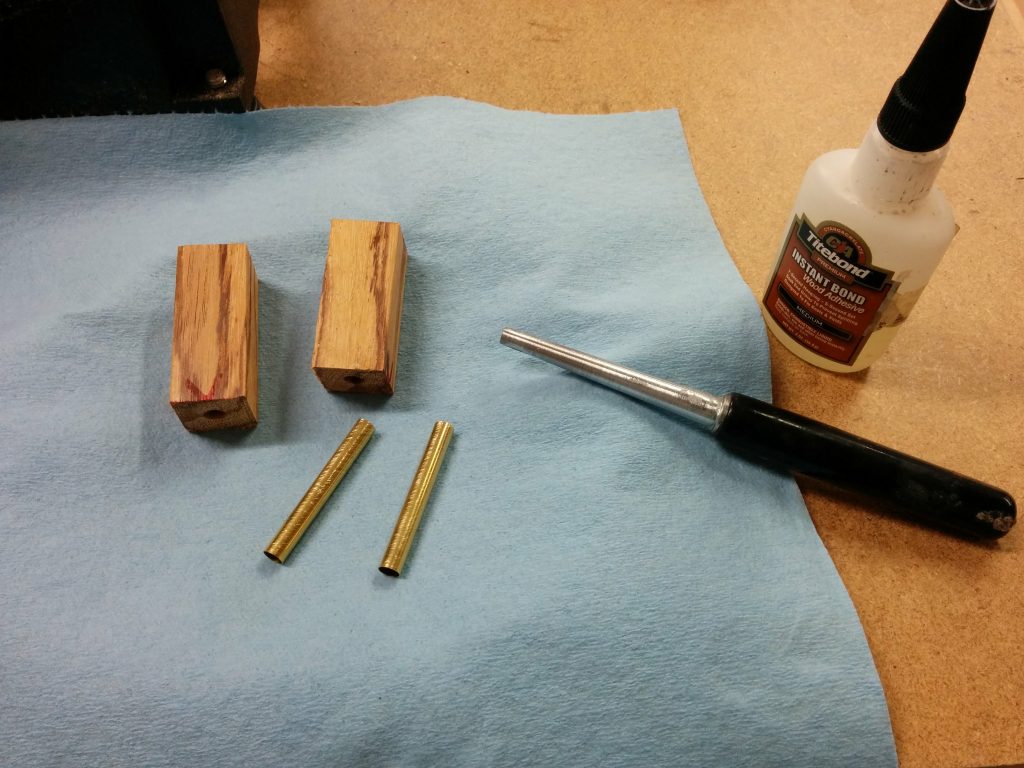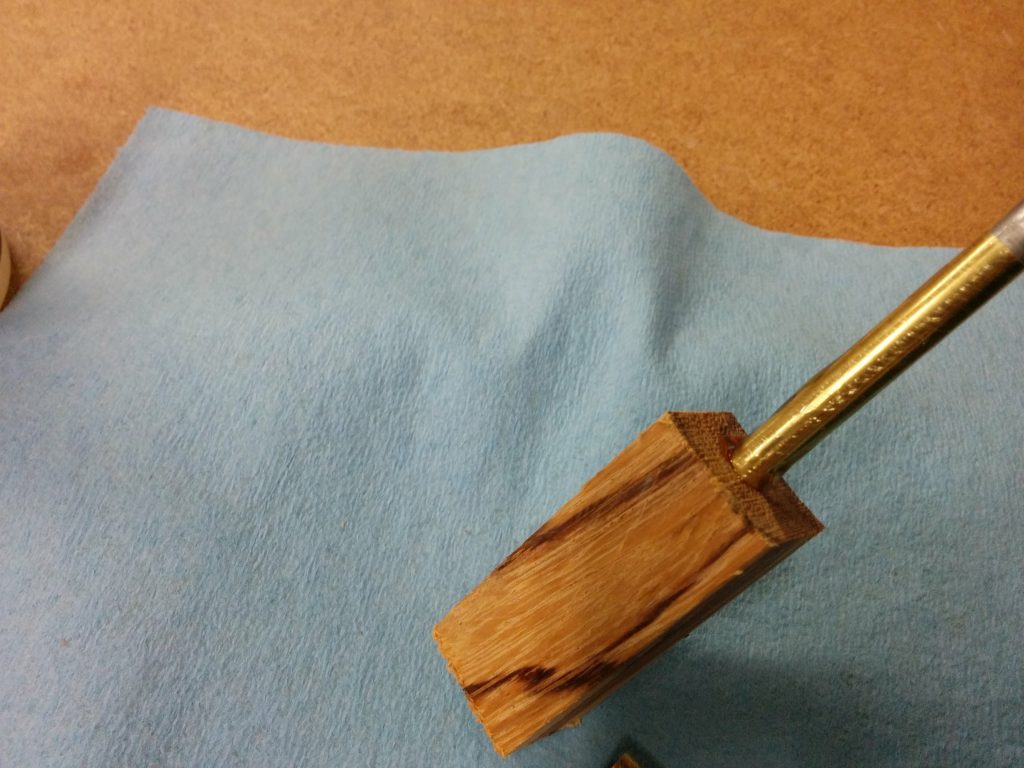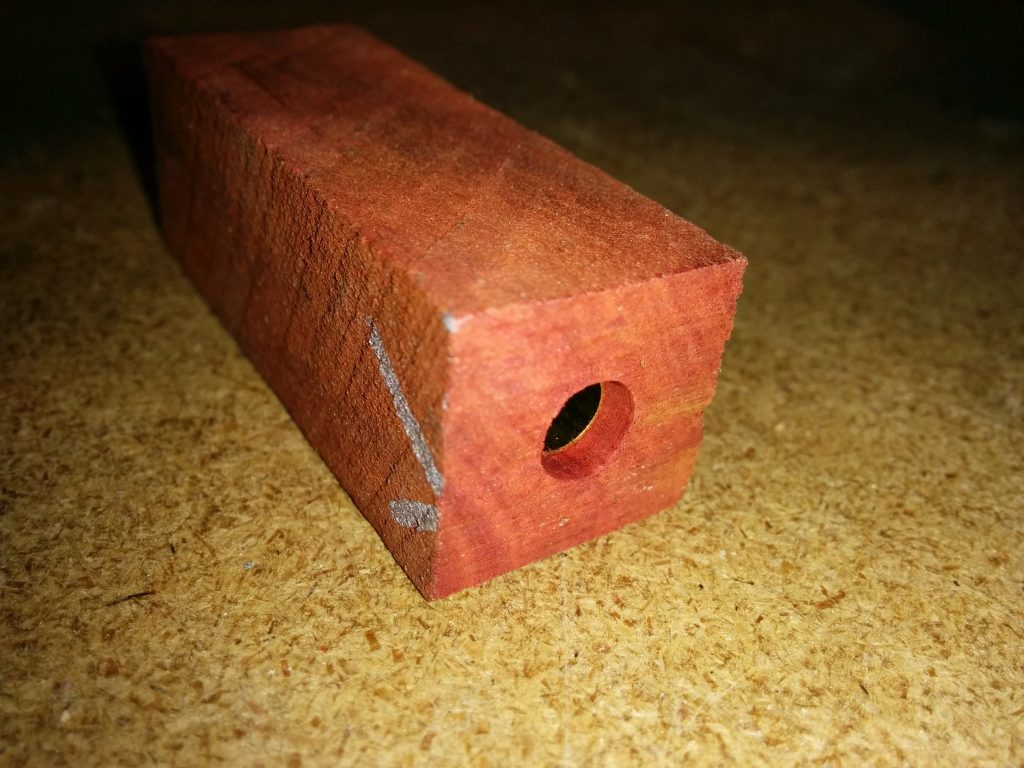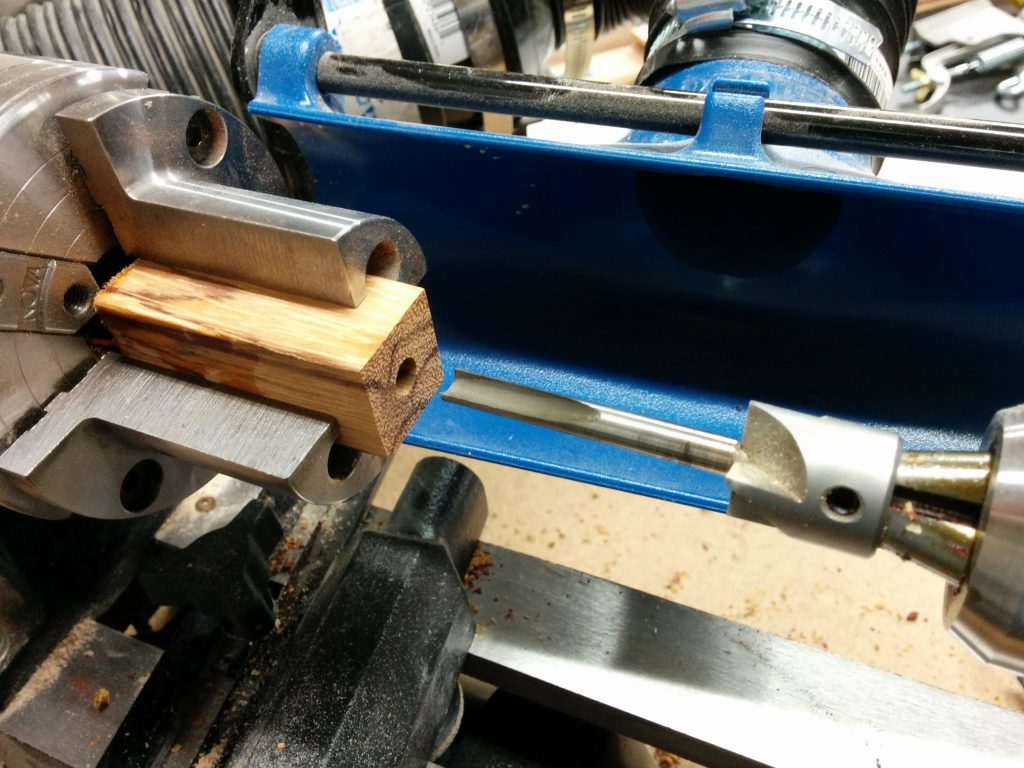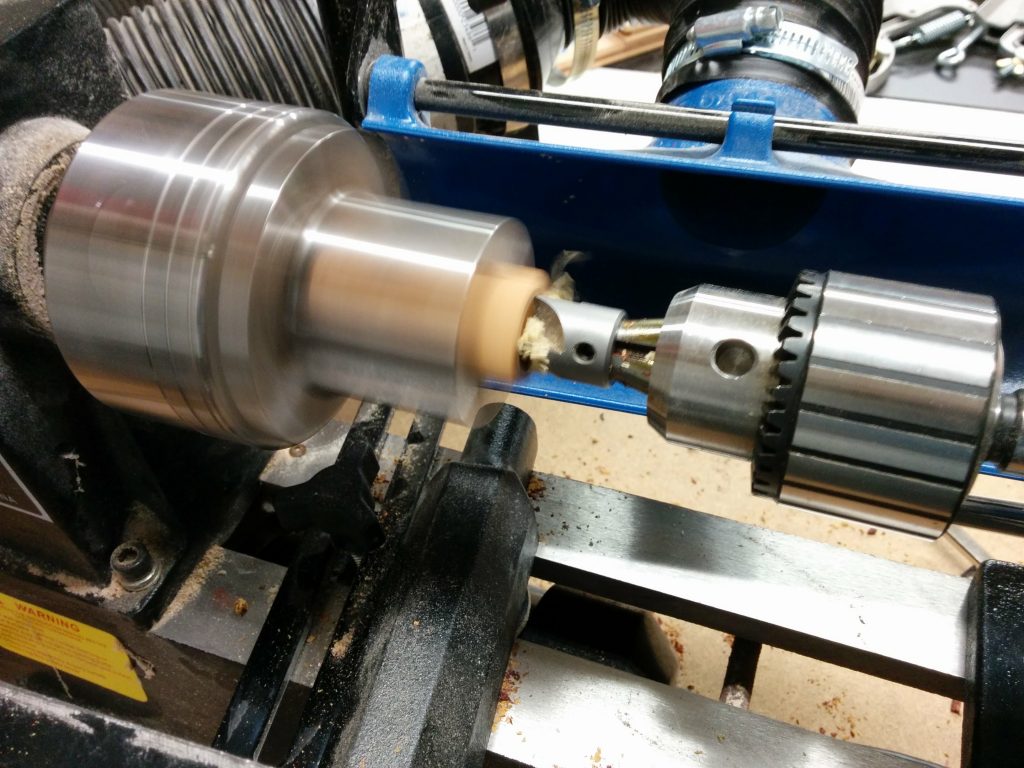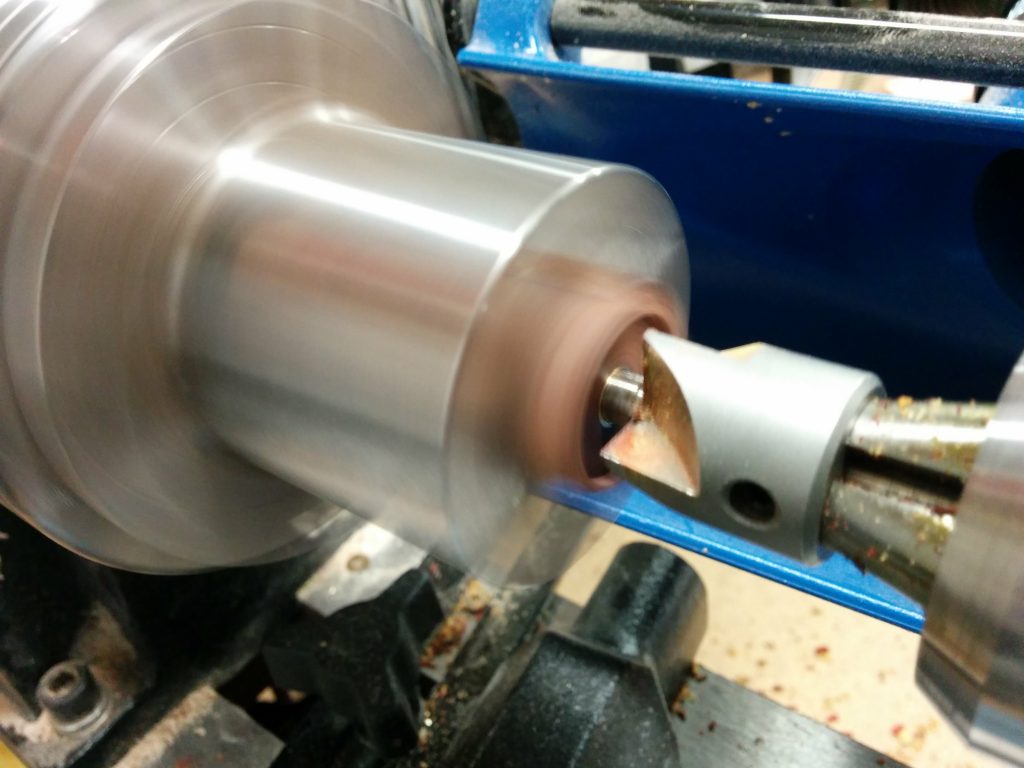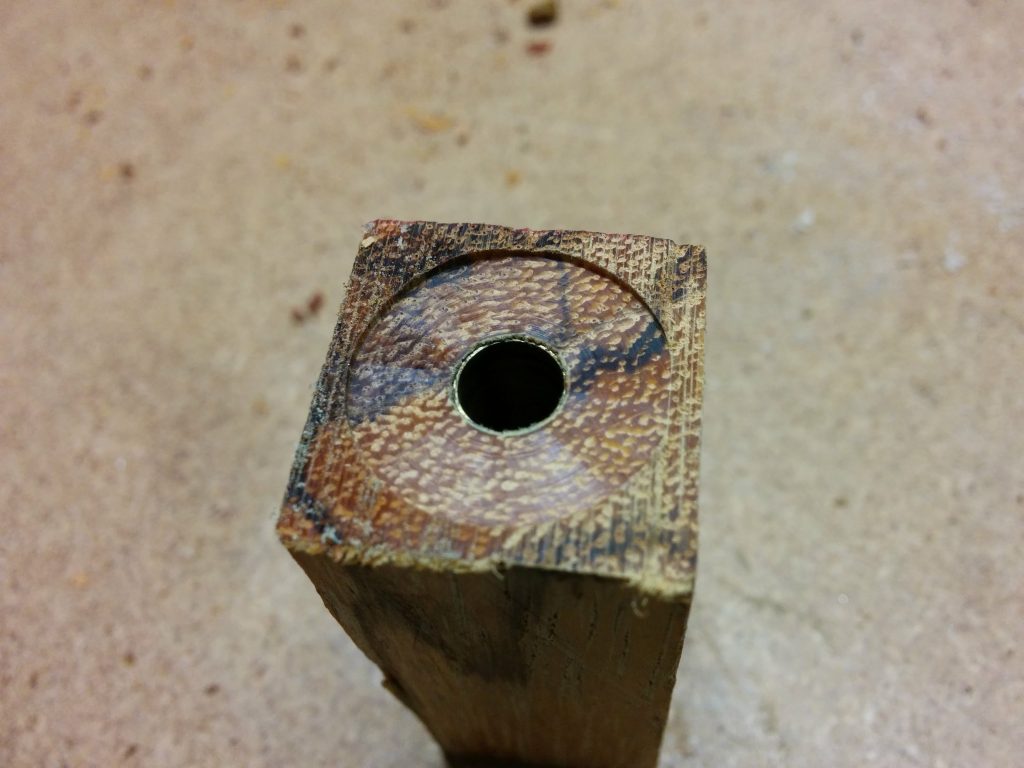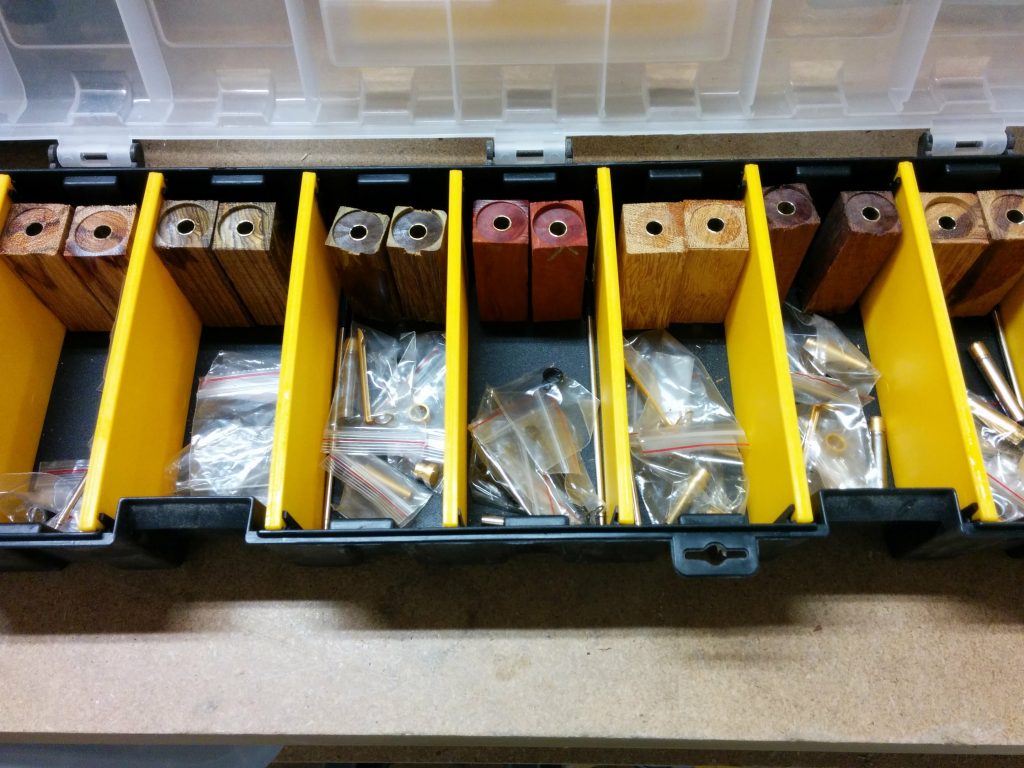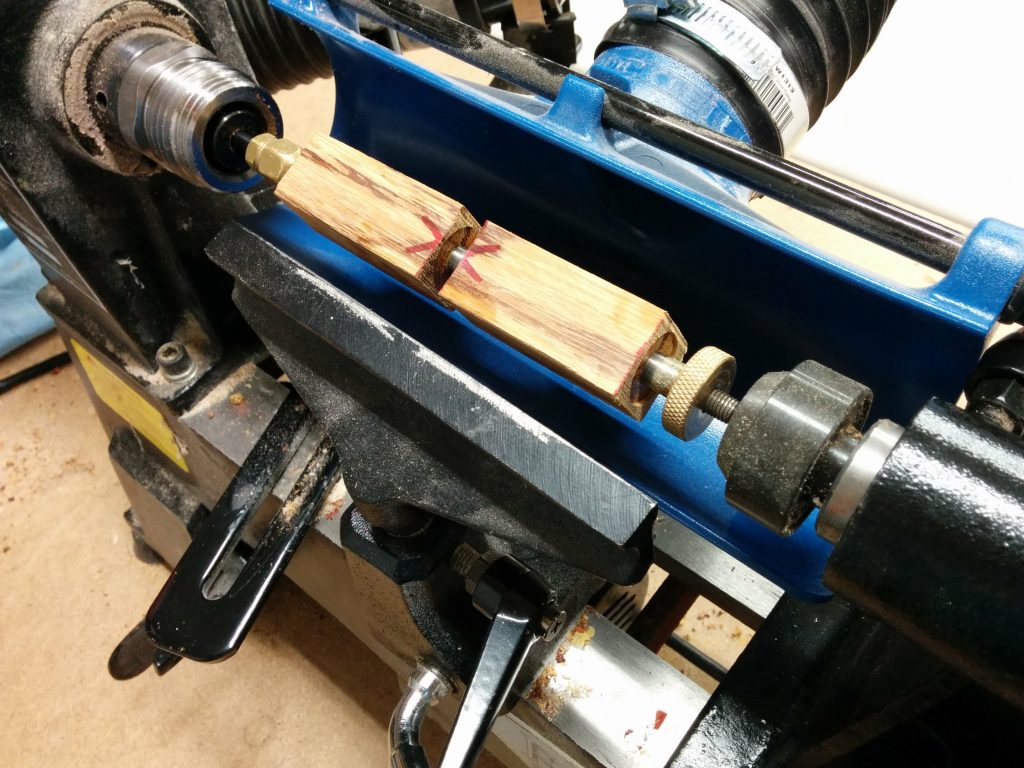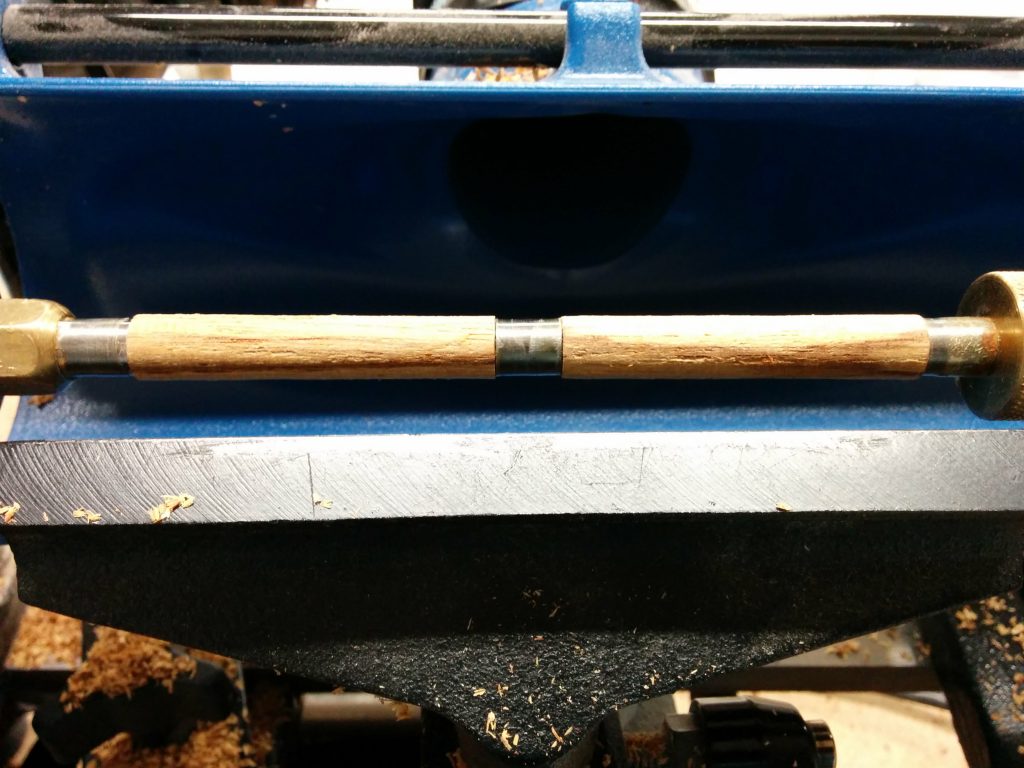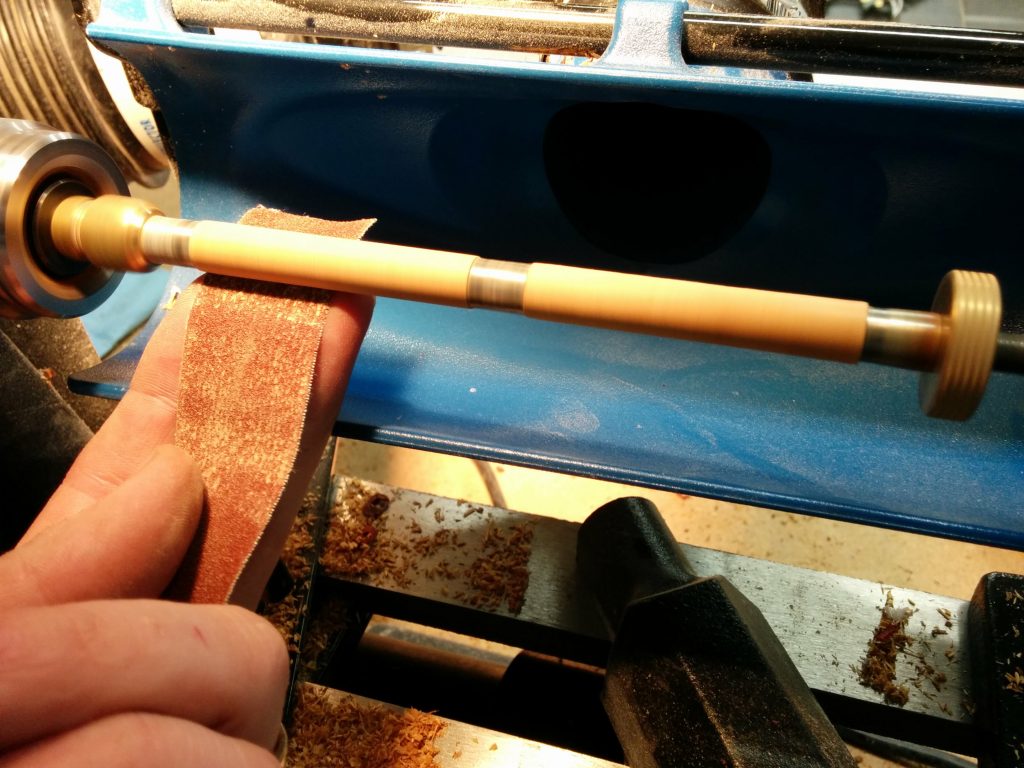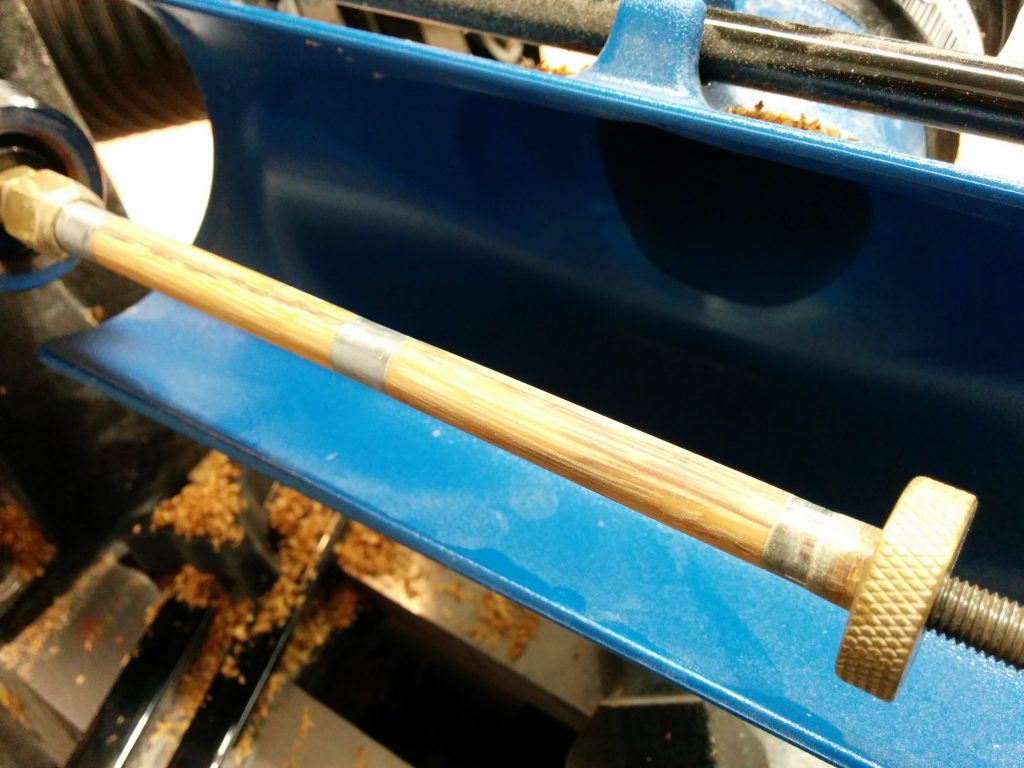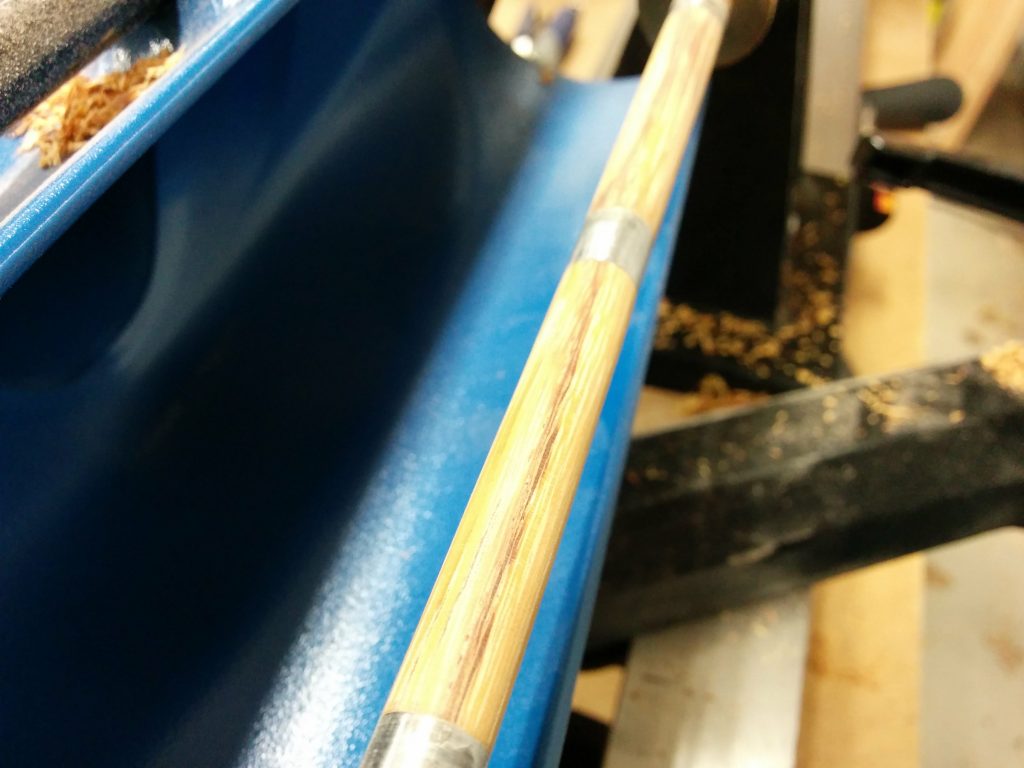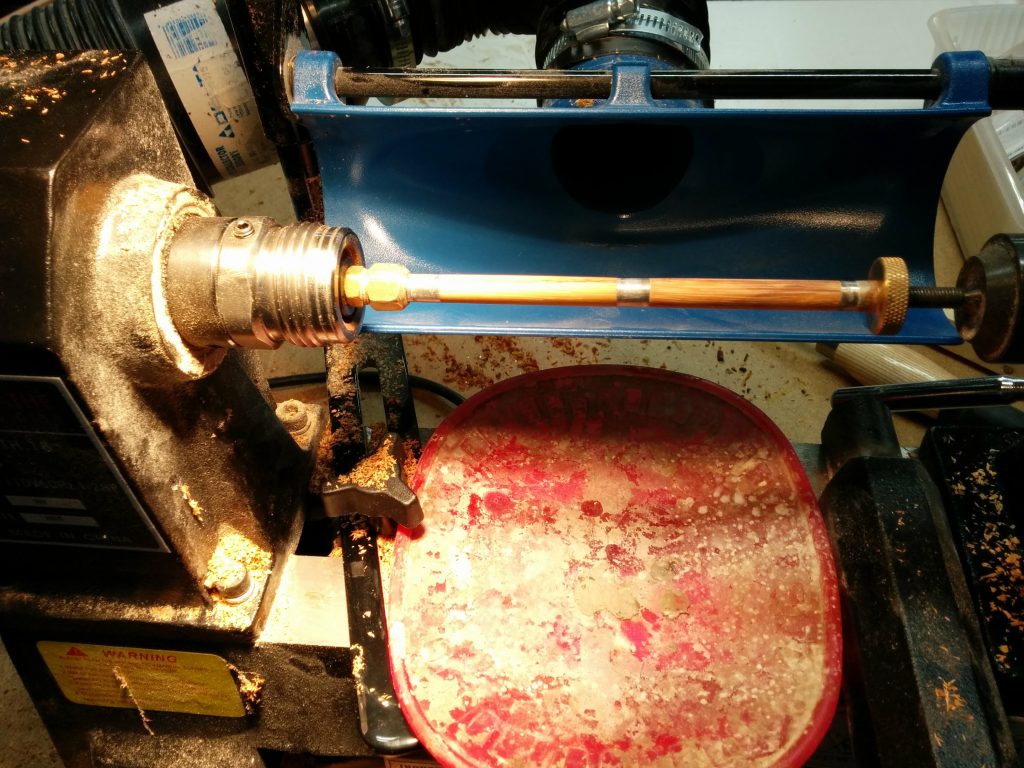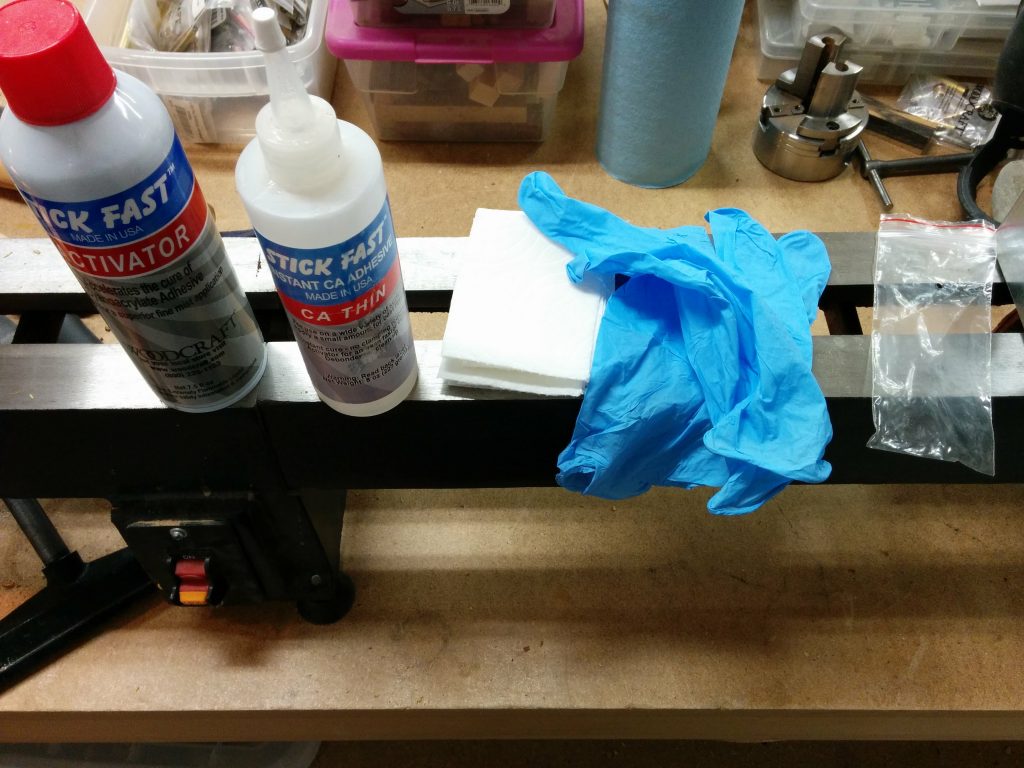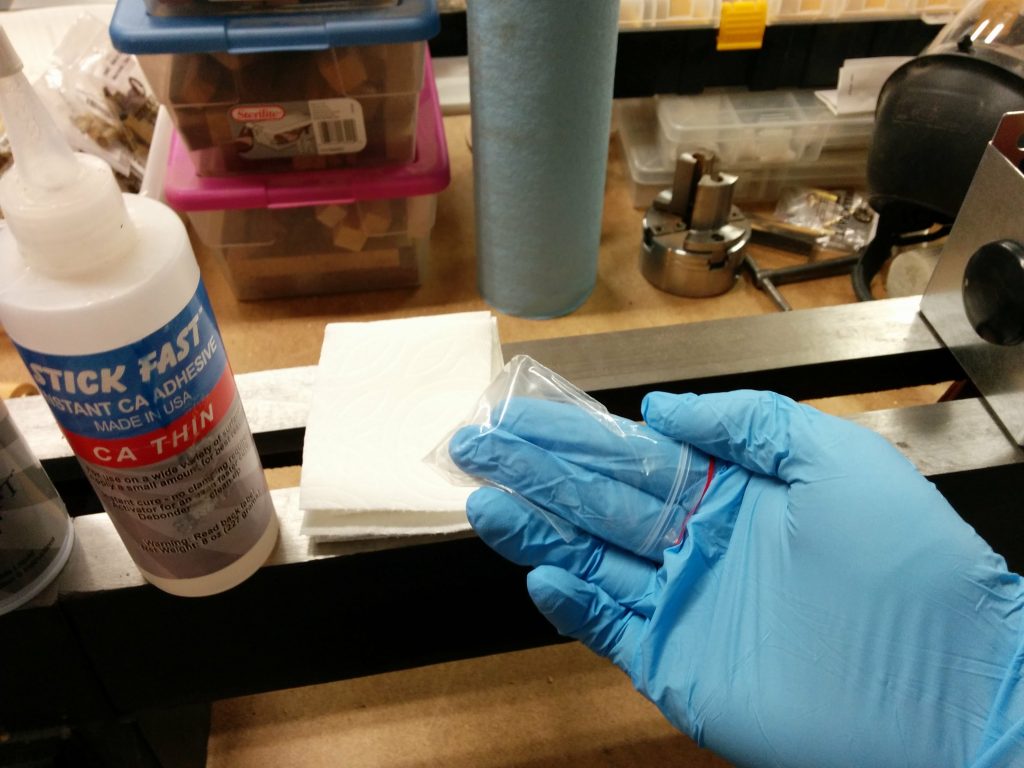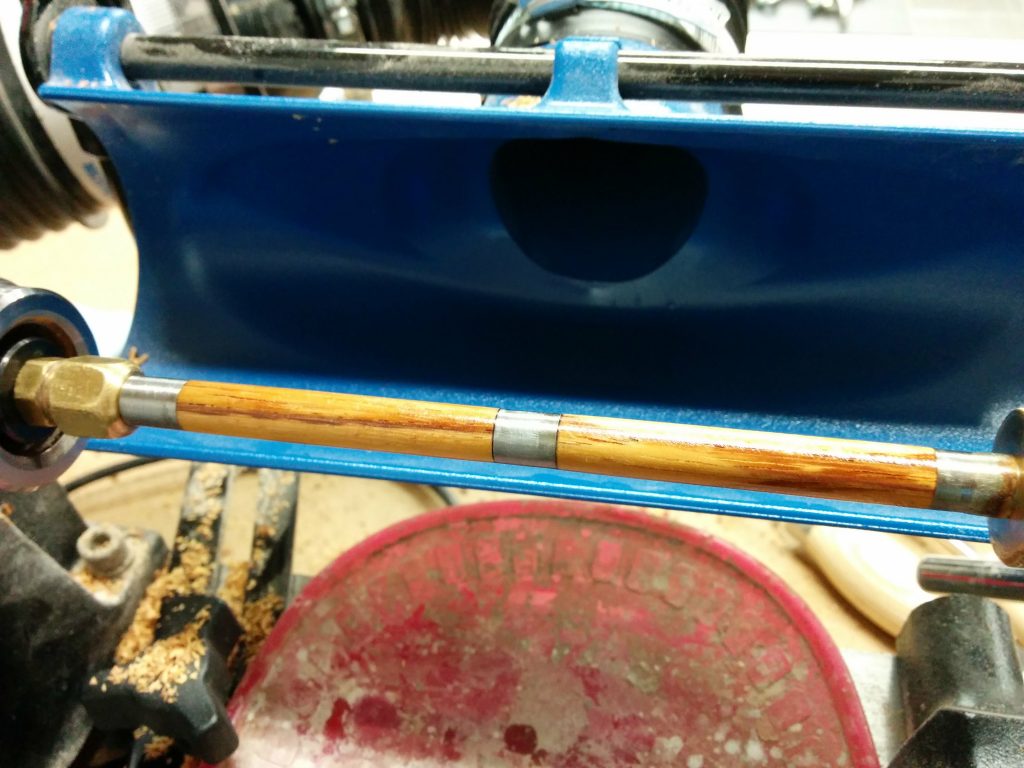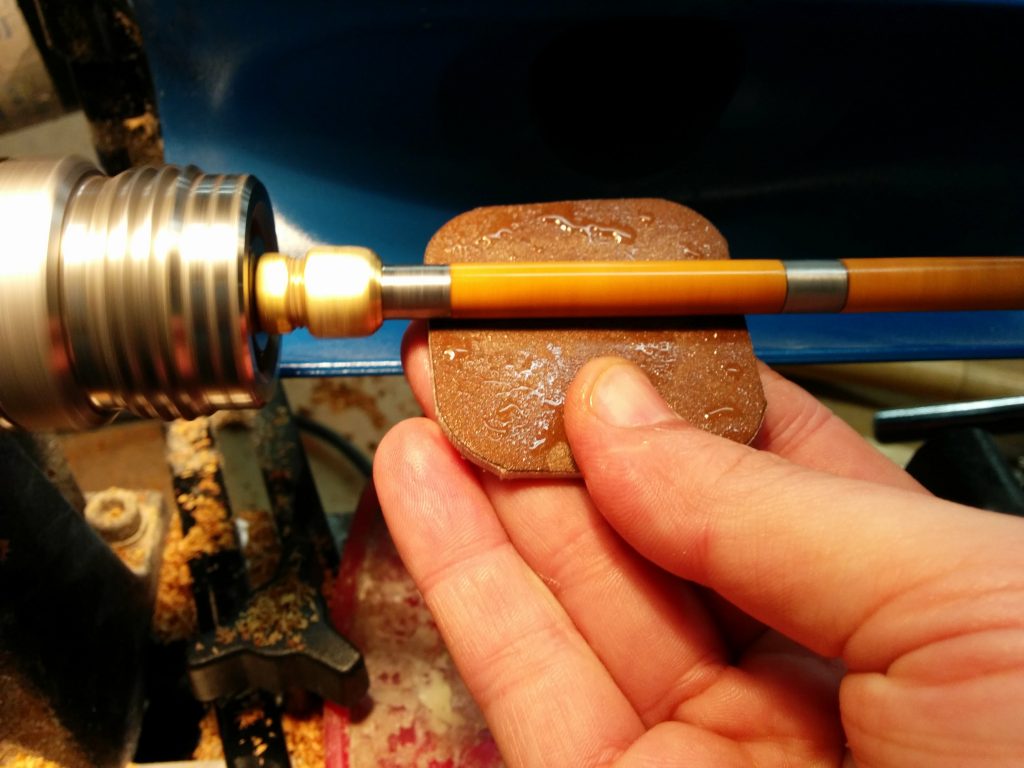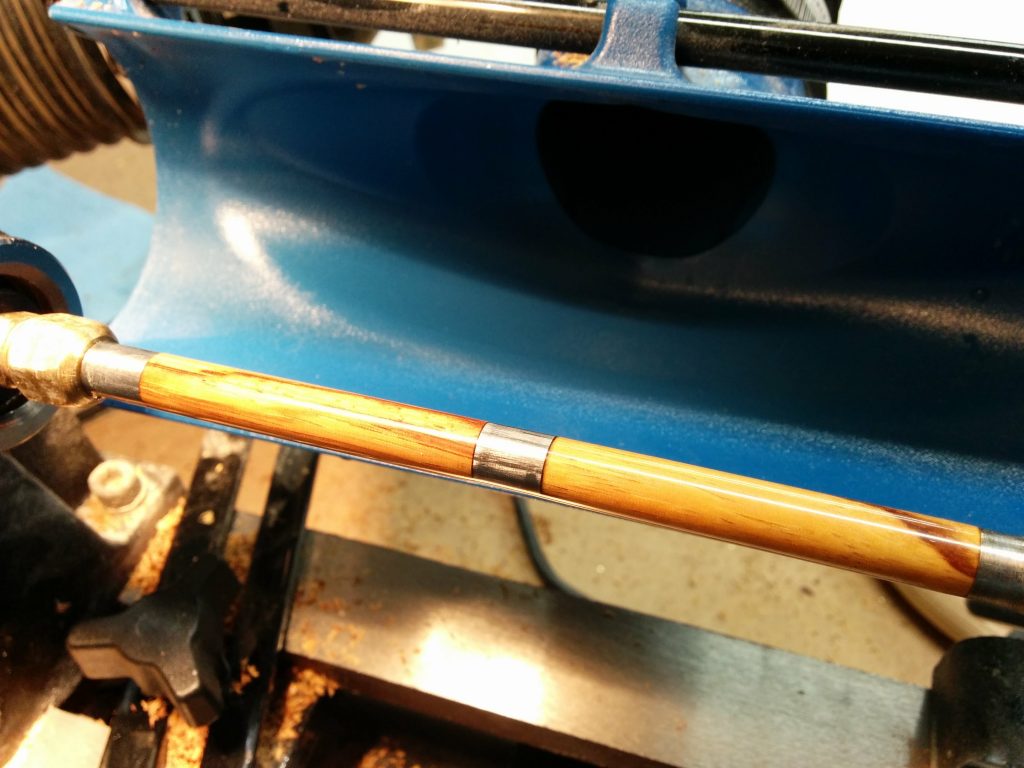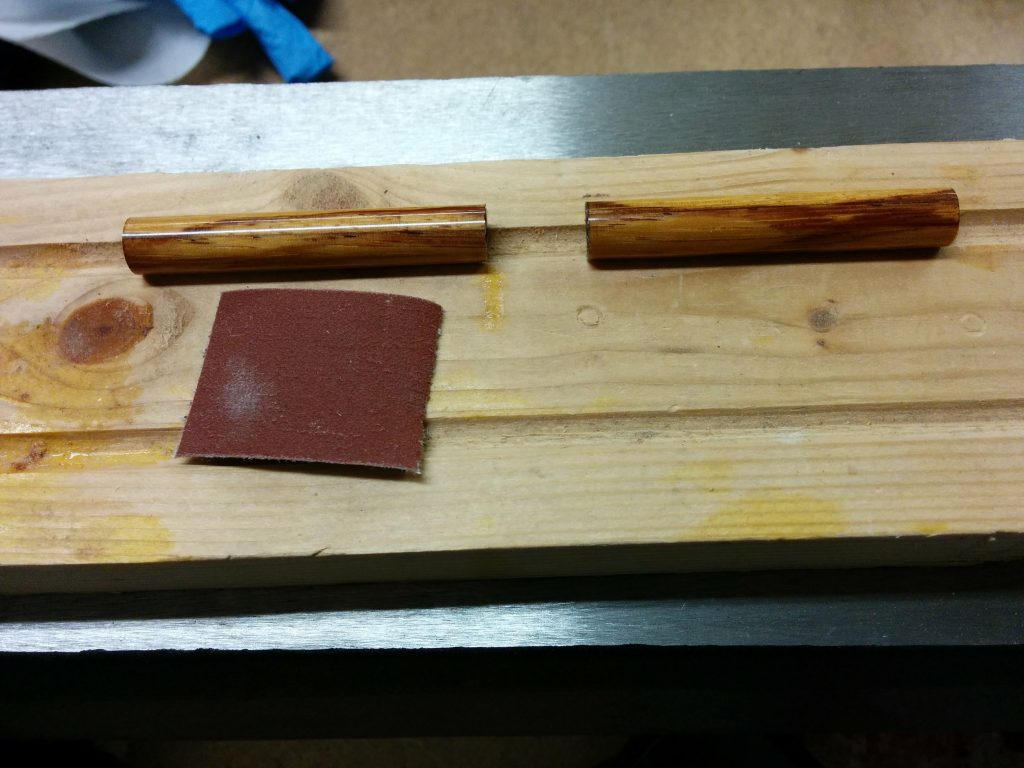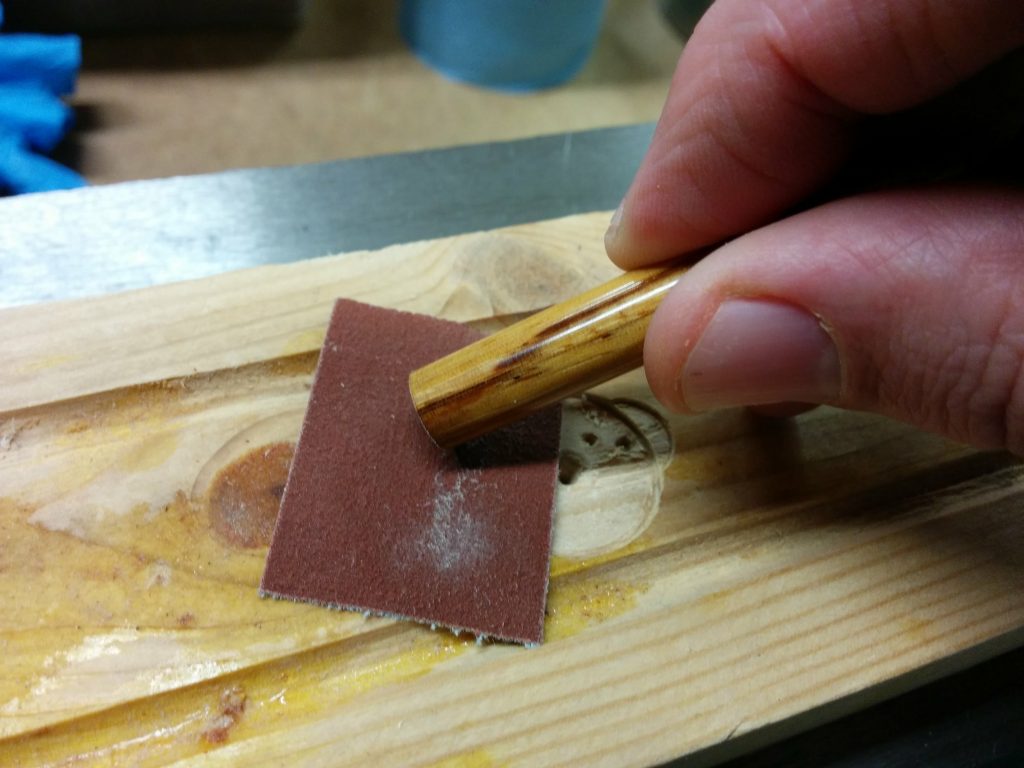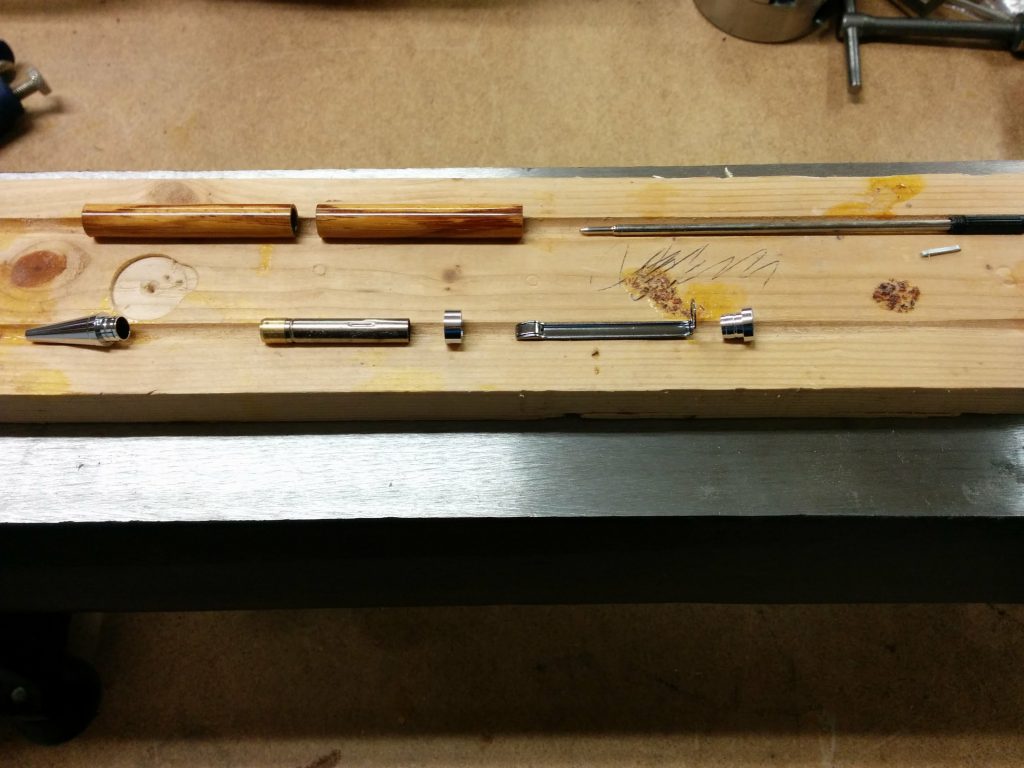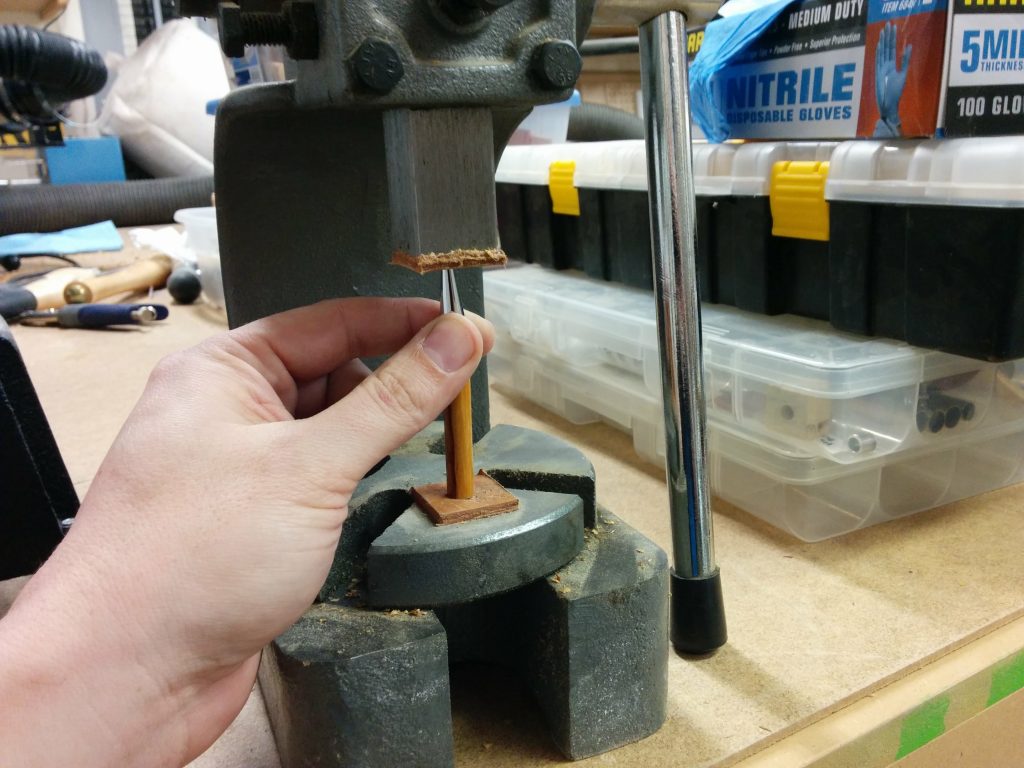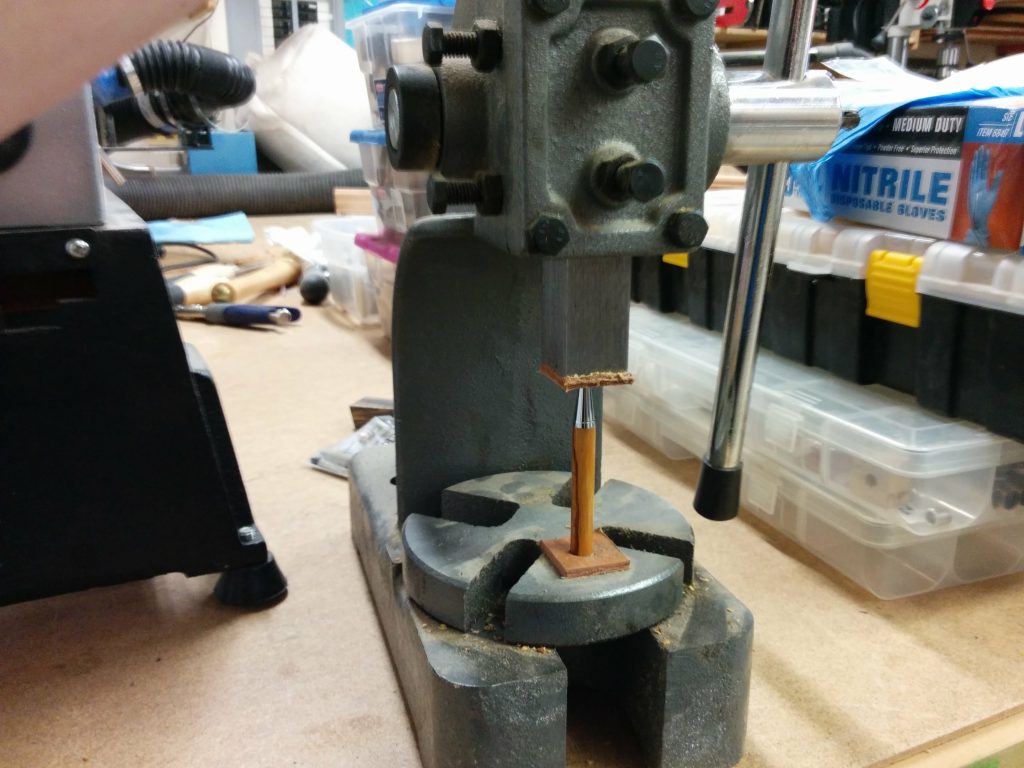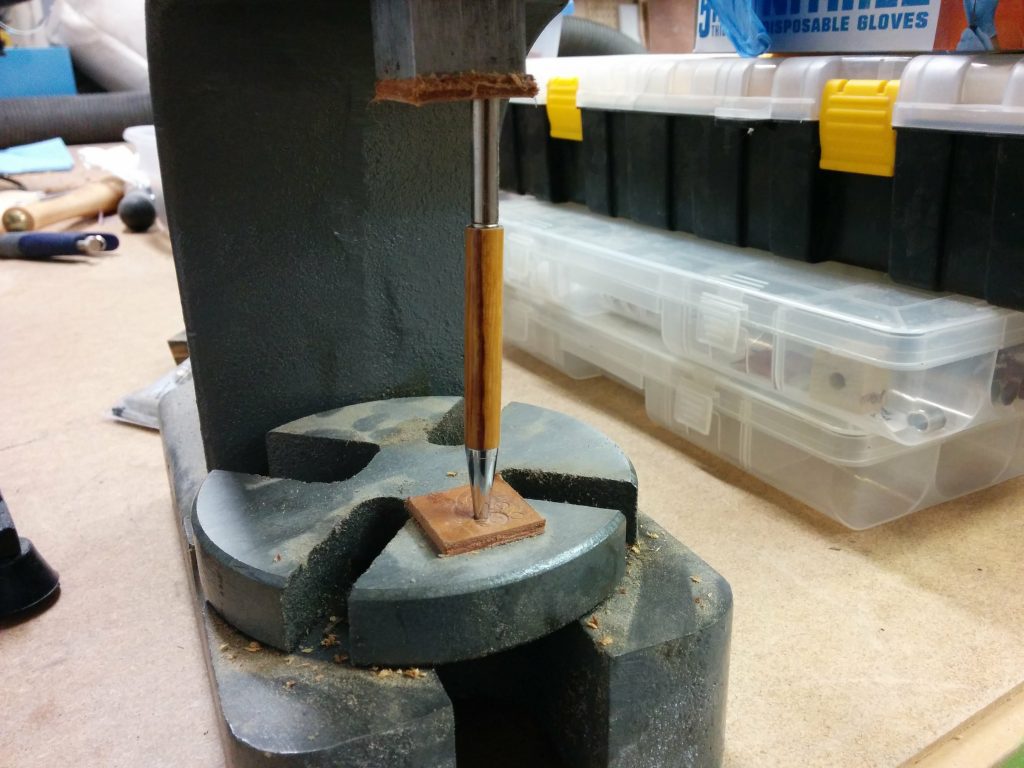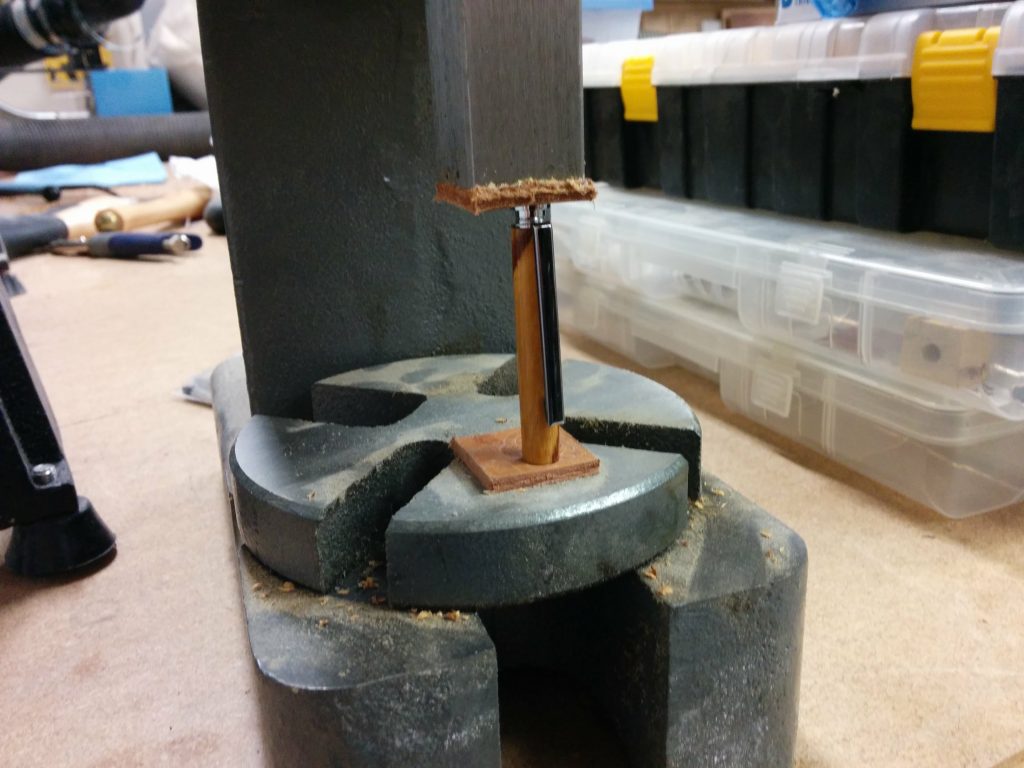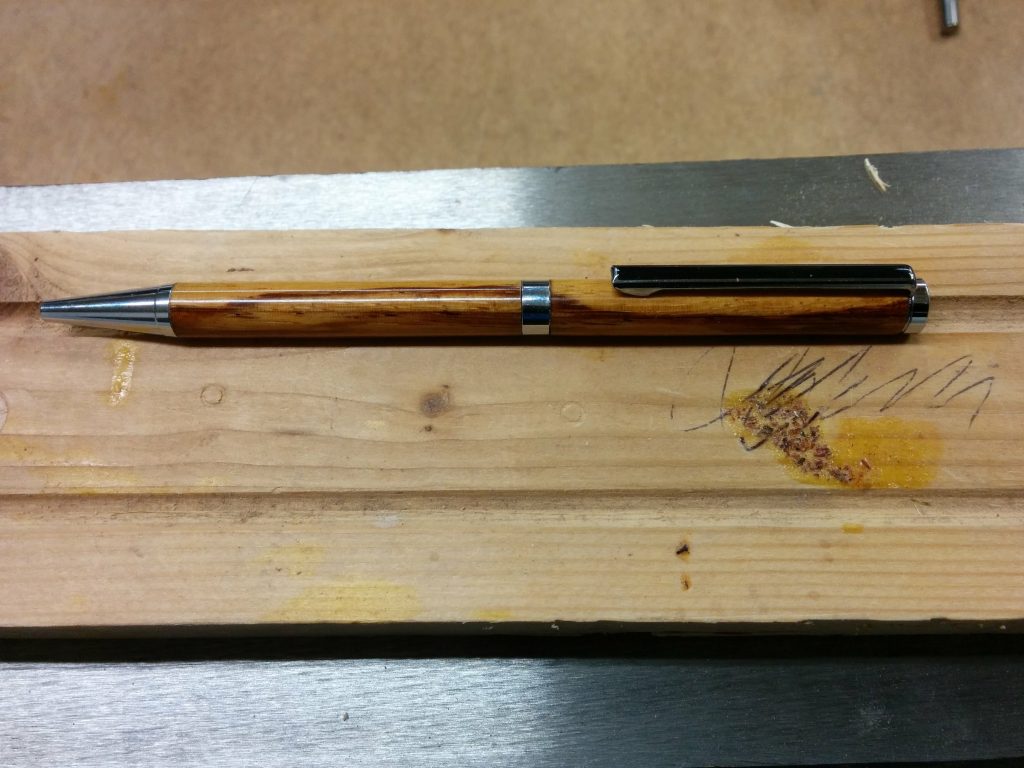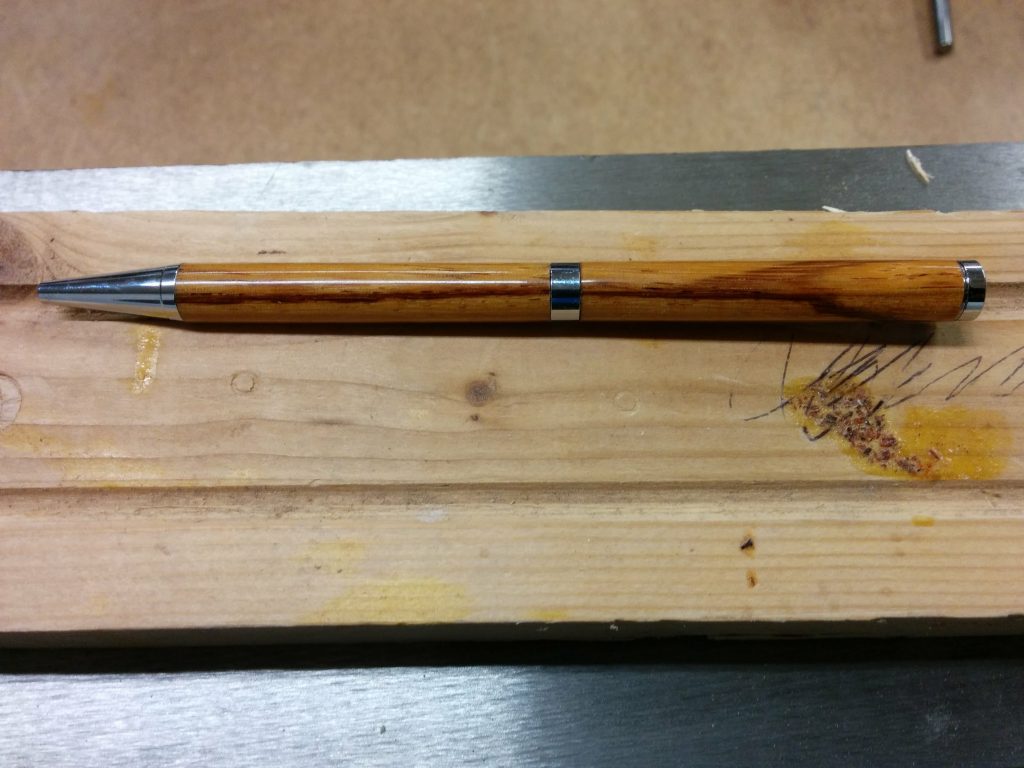For Christmas 2016, I decided to make some pens for my co-workers.
I remember when I first got started turning, and pen-making in particular, I would scour the web looking for different approaches and techniques from various wood-turners. I made a lot of expensive kindling in my attempt to learn to turn. Although I still have a lot to learn, I feel that I pretty much mastered the finish that I put on my pens.
In an effort to educate, I have roughly documented my technique below. This isn’t intended as a complete tutorial; more of an outline of my process. If this post generates enough interest, I will make a more detailed walk-through and an accompanying video. If you are interested in such a tutorial, please leave a comment at the end of this post.
I started by choosing a pen blank to go along with the kit. I try to look for pen blanks that have a lot of character, although sometimes a flat walnut will look good with the correct hardware.
For this project, I used a storage caddy to hold the pen kits and blanks. Seven of the nine kits are classic slimlines. Two of them are Cigar pen kits from Woodcraft.
For each kit I lay out the blank and the tubes. I look for any markings in the wood that look interesting and focus there. Of course, the outer grain is going to most likely be different from the inner grain, but a look at the end of the blank can help show what type of character the finished pen will have.
Using one of the pen tubes and a silver Sharpie, I make a mark just past the length of the first tube. You’ll notice that the tube isn’t right up to the end of the pen blank. I’m not going for precision in this step. I just want to make sure that I have enough material for both tubes.
I draw a line over the mark using a 6″ combination square.
Then I lay the other tube on the blank using the newly drawn line and make another mark.
One trick that I picked up is that I make an “X” over the first line. This makes it easier to line up the wood grain once you put it on the lathe. You’ll see what I mean later…
Once they’re marked, I take the wood blanks to the band saw and cut on the lines I made. Here you can see them cut. The X that I made is now split in two, making it much easier to match up the wood grain.
I drill the holes for the tubes on my lathe. There are many ways to go about this but this is the method I prefer.
I try to stay consistent with how the blanks are lined up. For example, you’ll notice in the following picture that the wood has half of the “X” facing me and on the right end. After I finish drilling this piece I’ll put the other half in but I’ll make sure that the other half of the “X” is still facing me but this time it goes on the left end.
I drill out the blank being careful not to let the bit get too hot. I also have dust collection going and although it doesn’t get all of the big shavings, it does get the fine dust.
Another trick I picked up is to sand the tubes before inserting. I do this by wrapping a piece of 150 grit sanding strip around the tube and spinning it while pulling it through. Just be careful not to use that piece of sandpaper for anything other than the tubes.
Now it’s time to glue the tubes in place. I use a few cheap IKEA kids plates, which you’ll see later, while I’m making my pens. I use one with a blue shop towel or just a plain paper towel over it. This doesn’t necessarily protect the plate, but rather the plate keeps the blue towel from getting glued to the workbench. For gluing the tubes in place, I use Titebond Medium cyanoacrylate glue. I recently learned from another pen turner that he’s had problems with the chemicals in stabilized woods causing the cyanoacrylate to cure before getting the tube fully inserted. This results in a wasted tube and possibly the pen blank. Instead, he uses 5-minute epoxy.
I put a coat of the cyanoacrylate glue on the sanded tube and use an insertion tool to push the tube into the wood.
I always try to have some extra material. This gives me room to true up the edge but also helps the grain flow more smoothly by taking up the room that the center band takes up on the final pen.
Take your time with this. I’ve had certain woods, such as zebrawood, use this as an opportunity to split. You want to trim it down to the edge of the tube. If you see any brass shavings coming off with the wood shavings, you’ve gone too far. Not the end of the world, but still…calm down there, tiger.
Here you can see the edge of the brass tube showing. This is what I look for.
All the pieces are now ready to go on the lathe.
I mount the blanks on the pen mandrel using the “X” that I drew before to line up the pieces. I tend to turn my pens with the left side being the tip of the pen and the right being the end cap. It doesn’t matter how you do this, but I prefer to stay consistent. For slimline pens it doesn’t matter at all.
I’m not going to go into detail how I turn them. There are much better woodturners that you can learn that from. The important thing is that I turn it down to where it’s almost the final diameter.
I sand it to it’s final diameter and shape using cloth-backed 150-grit sanding strips. This is where having the dust collector on my lathe really comes in handy.
After sanding with 150-grit, I move on to 240, 320, 400 and finally 600. After each grit, I always stop the lathe and sand it left-to-right, or “with the grain”. This removes banding that can occur which is very visible since it goes across the grain of the wood.
Then I do a quick sanding with 0000 steel wool. One very important step at this point is to wipe down the sanded blank with denatured alcohol. This removes the extra sawdust while giving you a sneak peak at what the finish will do to the colors in the wood. Also, this removes surface oil from certain wood species that may keep the finish from adhering to the wood. If you skip this step with wood like Olivewood, you may find that the CA finish you apply will start to peel off at the edges almost immediately.
Here you can see one of the crappy IKEA plates that I put on my lathe for the remainder of the pen project. This thing is beat to hell. It is there to help protect the cast iron bed of the lathe.
To apply the finish you’re going to want a few things. I use a thin CA glue and a spray activator.
Additionally, I use a pair of nitrile gloves and an extra baggie that the pen kit came in. This is another trick that I picked up. I put the baggie over my first two fingers. Then I hold little pieces of paper towel that I use to wipe on the thin CA glue. When you apply CA glue, it gets pretty warm and can actually melt through the gloves. I find that using the baggies over my fingers helps the gloves last longer. Before doing this, I was typically changing my right glove with every coat of CA glue that I applied.
I will go into more detail on actually applying the CA glue in a later article. This is a photo of a pen after 8 coats of thin CA glue have been applied.
I then use a micro mesh sanding system to polish the CA glue. I sand it down using 1,500, 1,800, 2,400, 3,200, 3,500, 4,000, 6,000, 8,000 and 12,000 grit sanding sponges. I use the 1,500 grit sponge to do the bulk of the final shaping and smoothing. Also, as with the dry sanding done before, I always stop the lathe after sanding with each sponge and sand the pen going with the grain as well.
I lay out the pen blanks carefully so I don’t lose the orientation of each piece. Otherwise, the “X” that I drew earlier would be for nothing. I use a little scrap of 600-grit sandpaper to break the edges of the finish.
I simply angle the pen blank and carefully rotate it on the sandpaper. This removes the CA burr that has formed which if left in place can cause the finish to chip off when I press the pen together.
I have a beat up piece of scrap wood that I routed a few coves in so I can lay out the pieces without losing anything.
I use my small arbor press and a few scrap pieces of leather to put the pen nib in place.
Be careful not to put too much pressure on the pen and to guide the nib in straight.
Then I turn it upside down and press the twist mechanism into the pen. I push it in so the groove that is visible lines up with the top of the blank. It’s best to err on the side of caution. I usually press it in so it sits above the blank by a hair, then I insert the pen refill and twist it to see how the tip looks when fully extended. I also make sure that when the pen is twisted closed, the tip doesn’t still stick out past the end of the nib.
Then I grab the other half of the pen and attach the clip and end cap. You want to be careful that you have the orientation right. I also look for a part of the wood that had rather boring features and line up the clip there, although that can be adjusted after assembly.
Then I’m done.
Here are some photos of the finished pens.
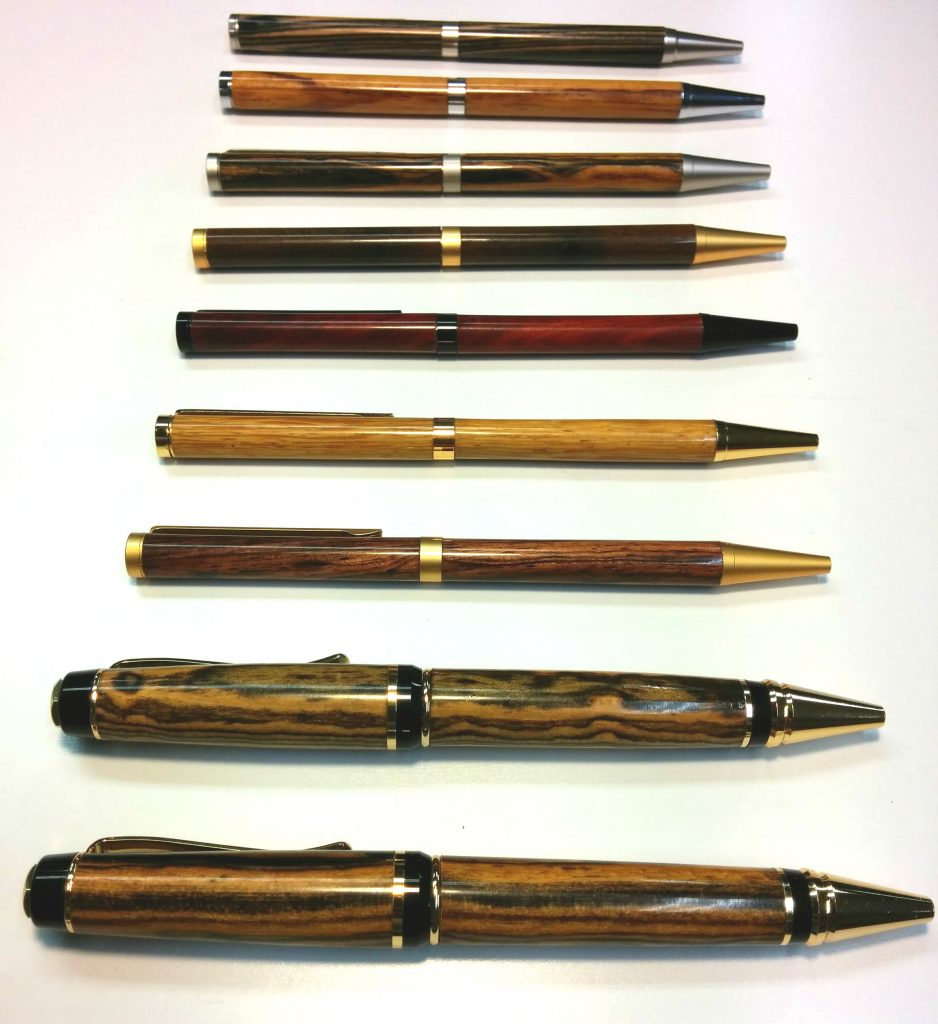









I hope that this was helpful. If you have any techniques or tricks to share, please leave them in the comments section below. Also, please consider signing up for my mailing list to be notified of future articles. I am also available on social media and can be reached at the links below.

